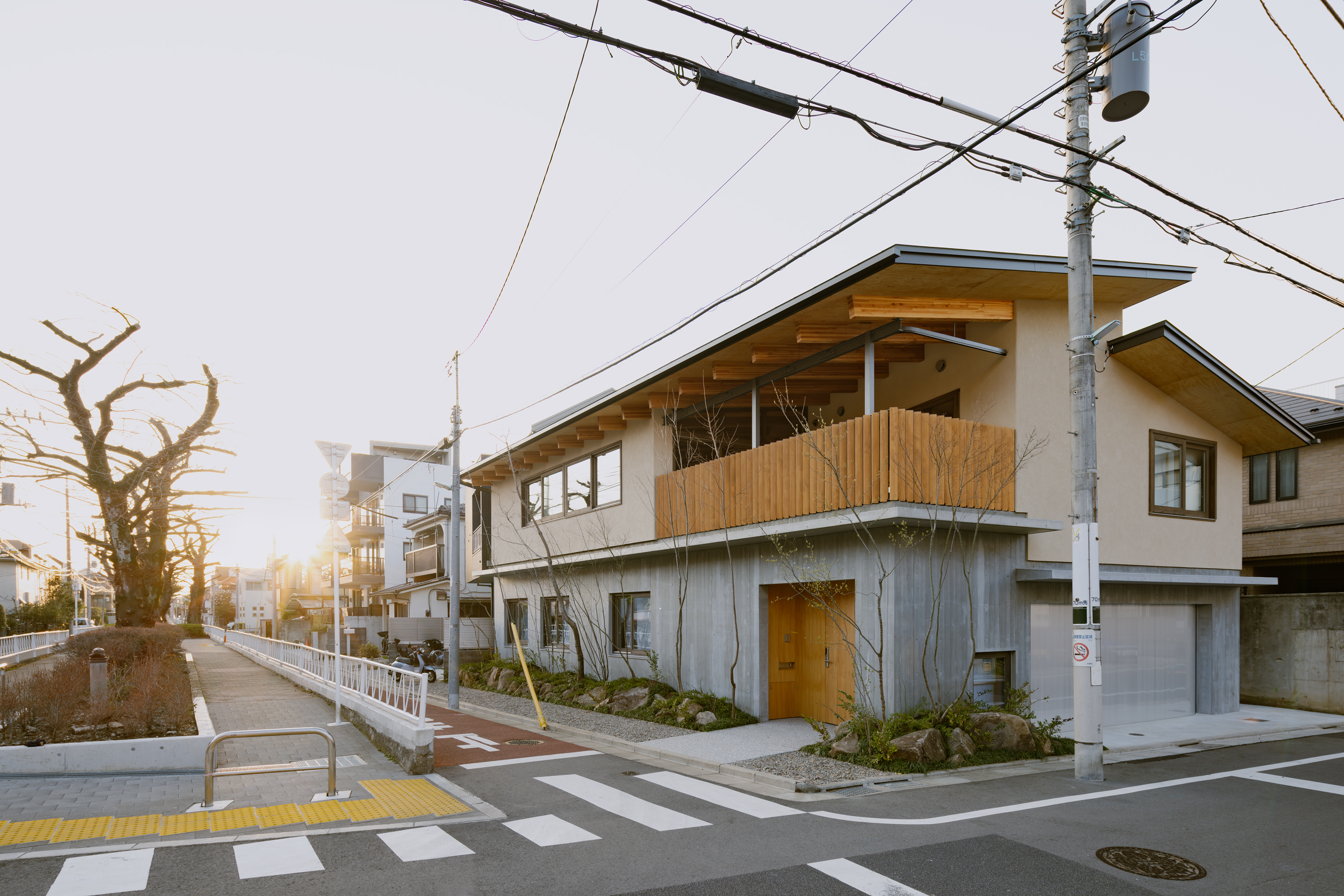
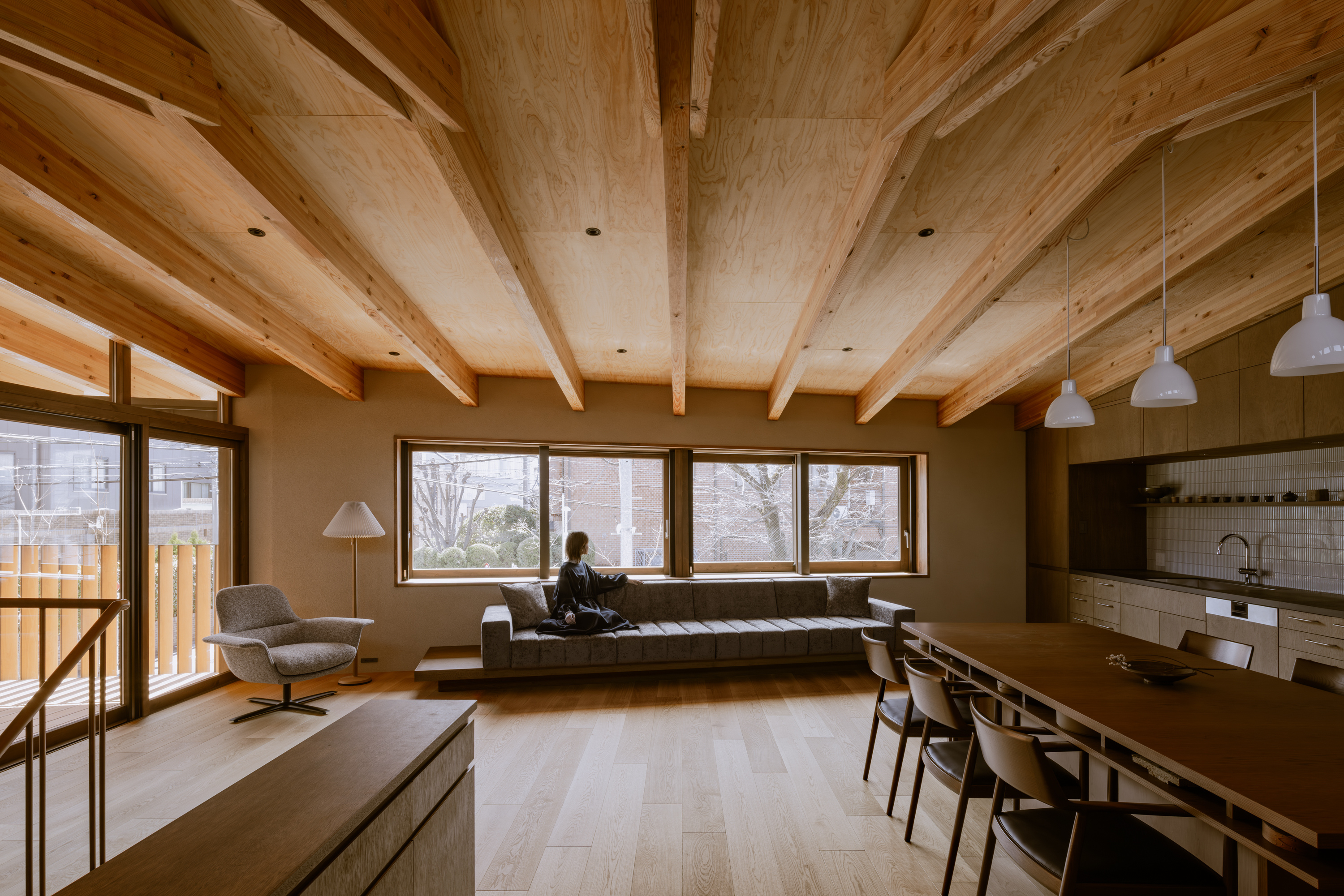
设计单位 小大建筑设计事务所 + 磯田和明
项目地点 日本东京
建成时间 2024年3月
建筑面积 265平方米
本文文字由设计单位提供。
这是一栋坐落于自然环境优越之地的住宅,面朝樱花树成荫的步道(原为小川,后改为暗渠),拥有良好的视野、通风和采光条件。为了回应业主“每天在日出中醒来,仰望天空,感受自然光和风”的愿望,我们对住宅的构成进行了深入思考。
This residence is built in a natural environment blessed with scenic views, ventilation, and sunlight, facing a row of cherry trees planted over a culverted stream. The design was developed to reflect the client's desire to live in harmony with nature—waking up with the sunrise and experiencing natural light and breeze while looking at the sky.
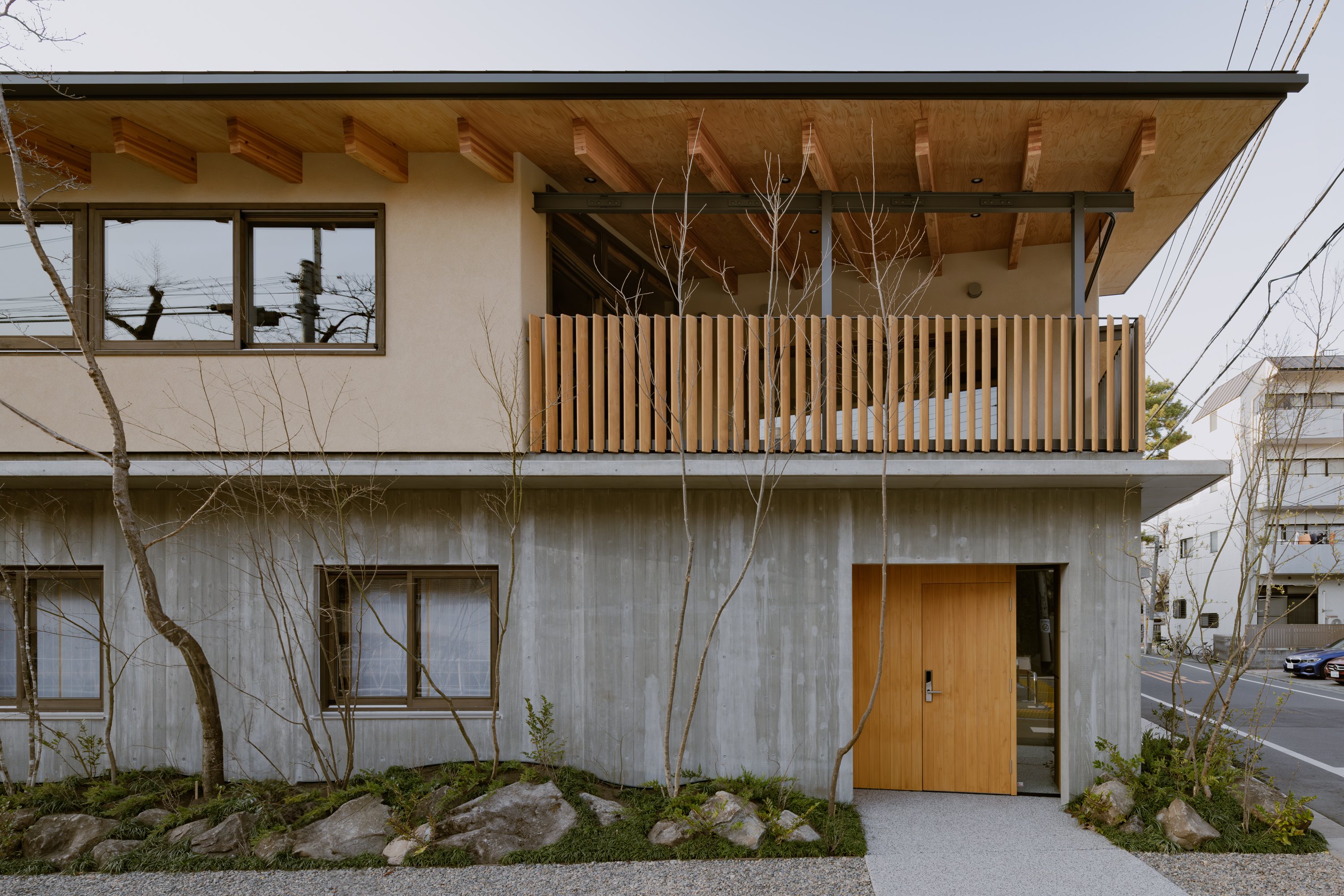
考虑到住宅南侧紧邻绿道与樱花林,设计中力求最大程度地向南开敞。同时,受日本北侧斜线高度限制的影响,北侧建筑需相对降低高度。于是我们意识到,在南北方向上设置不同的层高是一种合理的建造方式。
Considering that the south side of the residence is adjacent to a greenway and a cherry blossom forest, the design strives to open up as much as possible to the south. At the same time, due to the height restrictions imposed by the north-side setback regulations in Japan, the buildings on the north side need to be relatively lower in height. As a result, we realized that adopting different floor heights in the north-south direction is a reasonable construction approach.
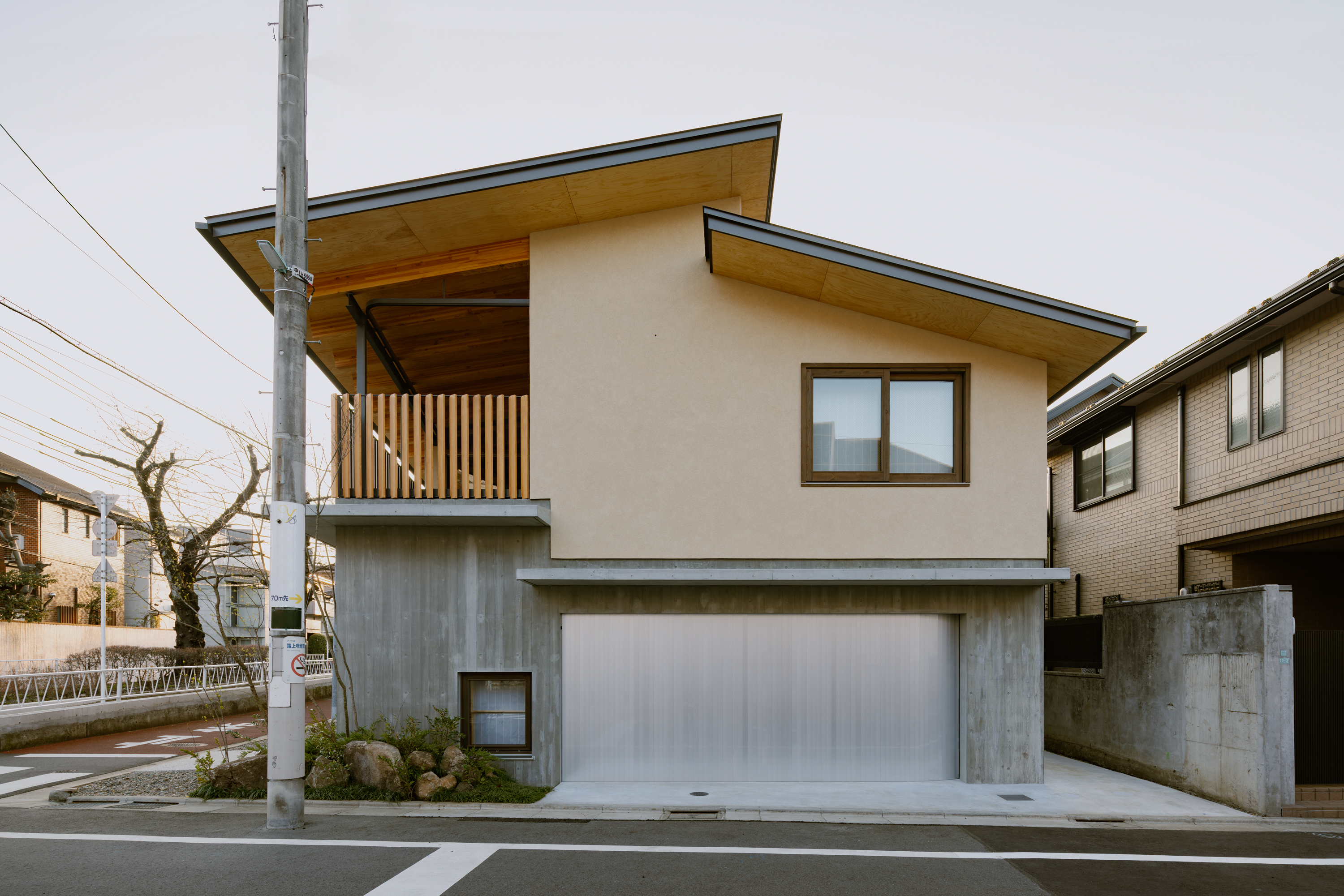
东西方向上塑造出开阔而延展的空间的同时,在南北方向引入错层结构,将不同高度的水平面嵌入建筑中。我们尝试将这些由高低差产生的空隙视为光线、风,以及人的流动路径,以此来打造一个舒适宜人的居住环境。
The horizontal planes are arranged with level shifts, creating gaps that act as pathways for light, wind, and movement—aiming to cultivate a comfortable and pleasant living environment.
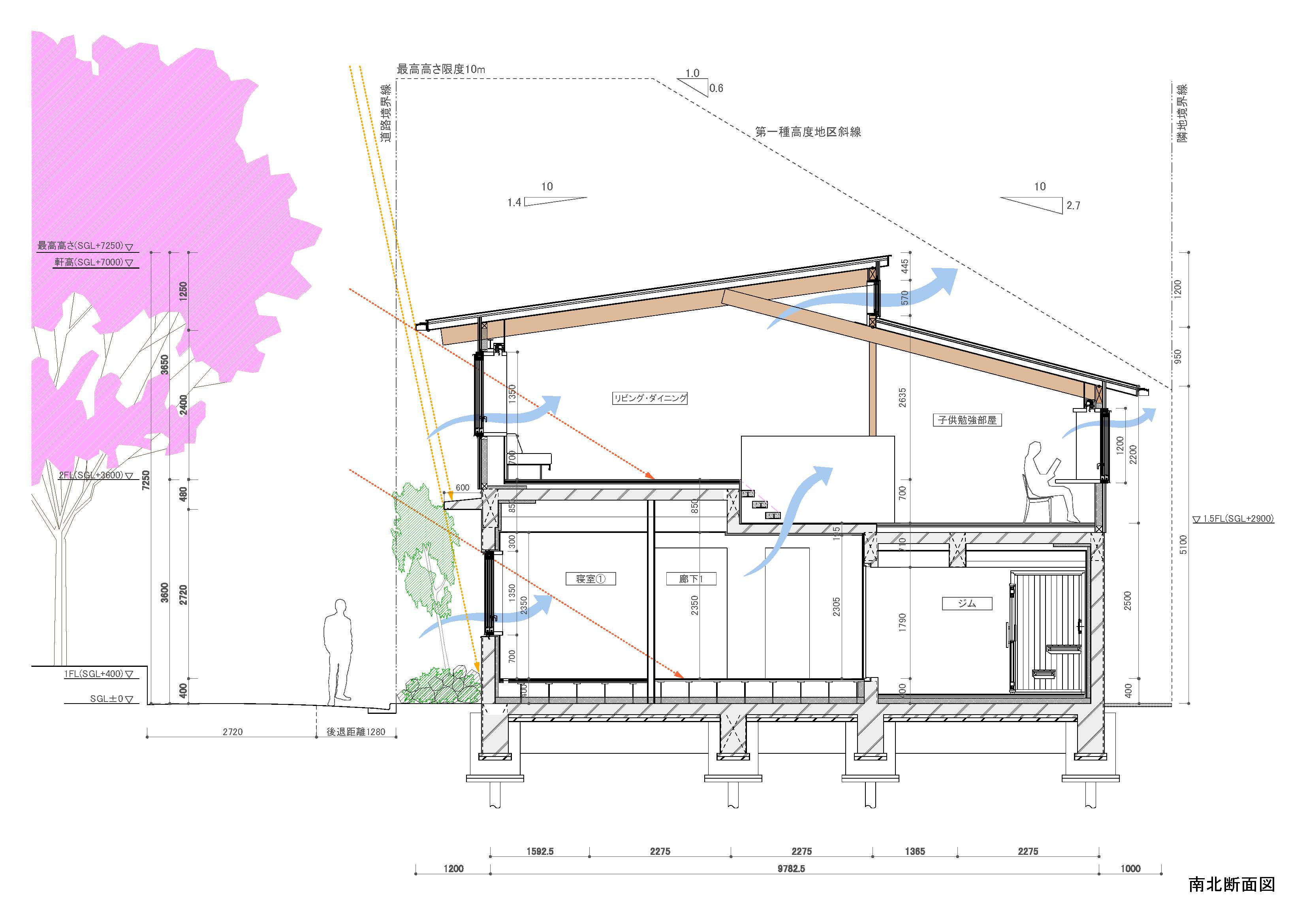
玄关设有嵌饰天然小石的土间区域,与室内无缝连接,细致而温馨地迎接家人和来客。
The entrance features a seamless transition from a traditional earthen floor embedded with natural pebbles, warmly welcoming family members and guests with care and intention.
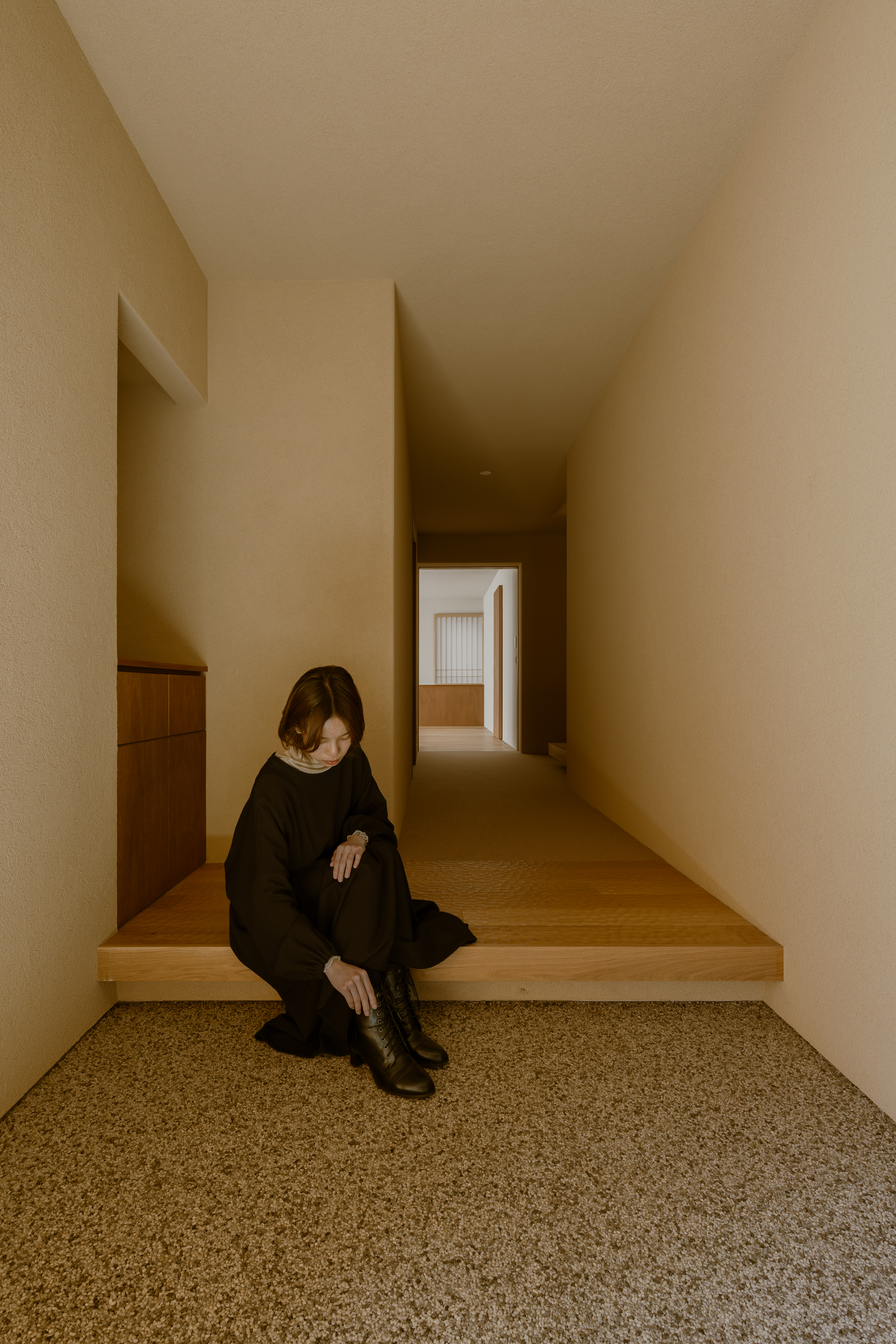
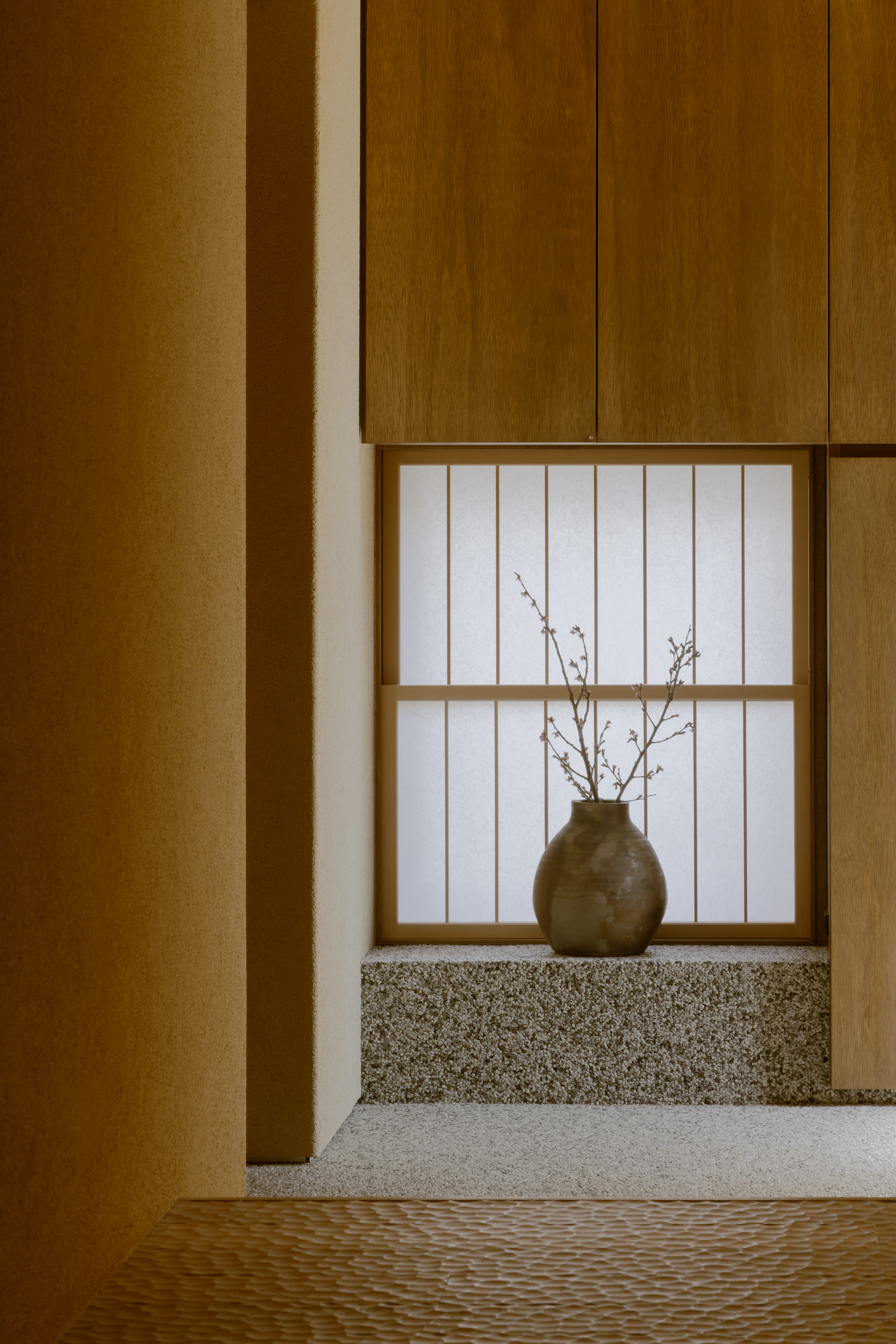

正面设置了一扇由手工精心拼贴而成的漆涂和纸门扉,并配以经过名栗加工(Naguri)的把手。以楮纸制成的和纸涂上漆后,门扉不仅展现出独特的质感,还提升了强度,随着时间的使用更能展现出深厚的风味。
At the front, a door adorned with hand-applied lacquered washi paper and a handle crafted with naguri carving technique sets the tone. The washi, made from kōzo (paper mulberry), is coated with lacquer, creating a unique texture that not only enhances its durability but also deepens in character with use over time.
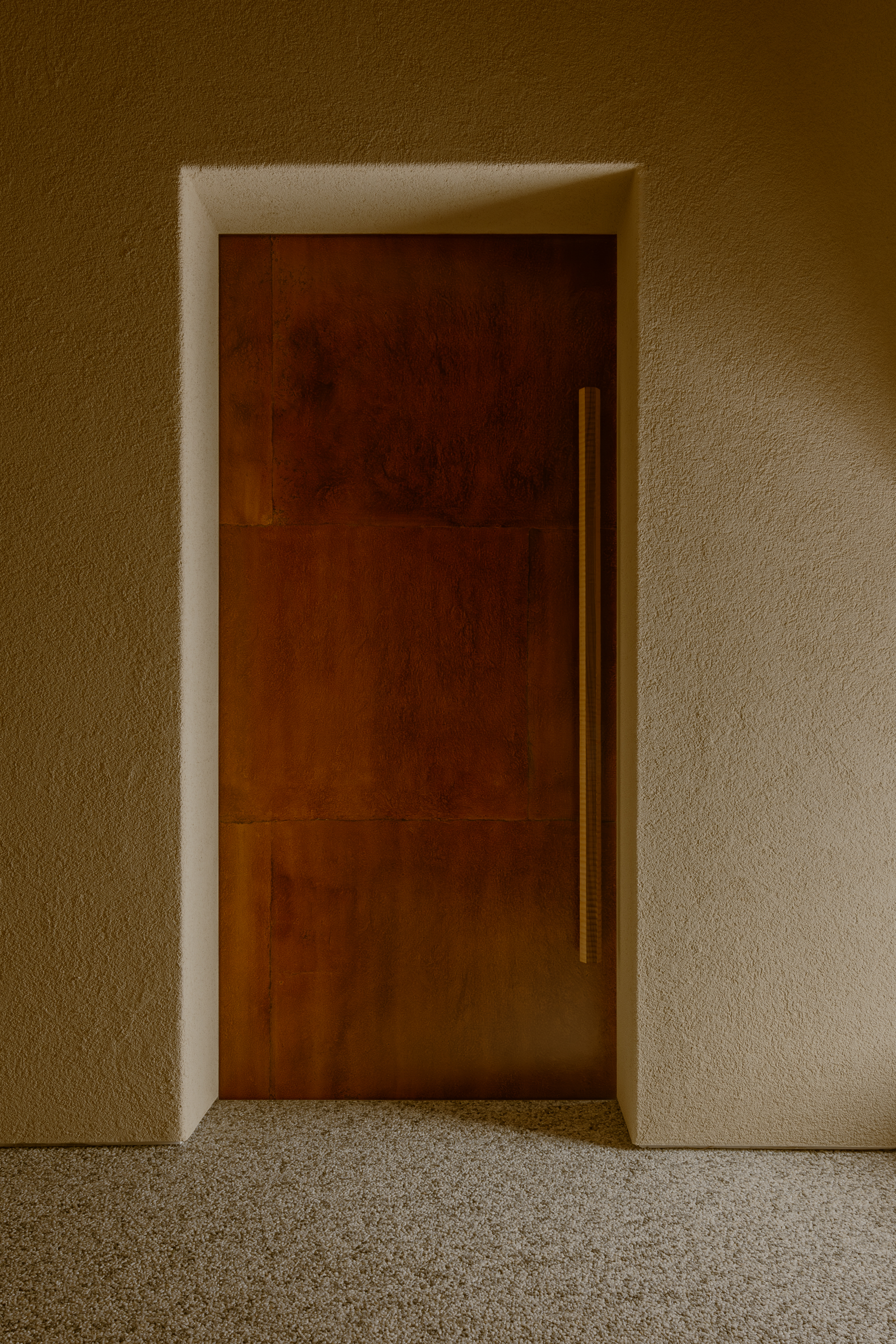
把手则是由栗木与胡桃木两种木材交替拼接成六角形,再施以名栗加工,使其在不同角度展现出丰富的表情,同时也带来富有趣味的握持触感。
The handle is composed of alternating pieces of chestnut and walnut, joined to form a hexagonal shape. Through the naguri technique, it offers a variety of expressions depending on the viewing angle and provides a tactile pleasure when gripped.
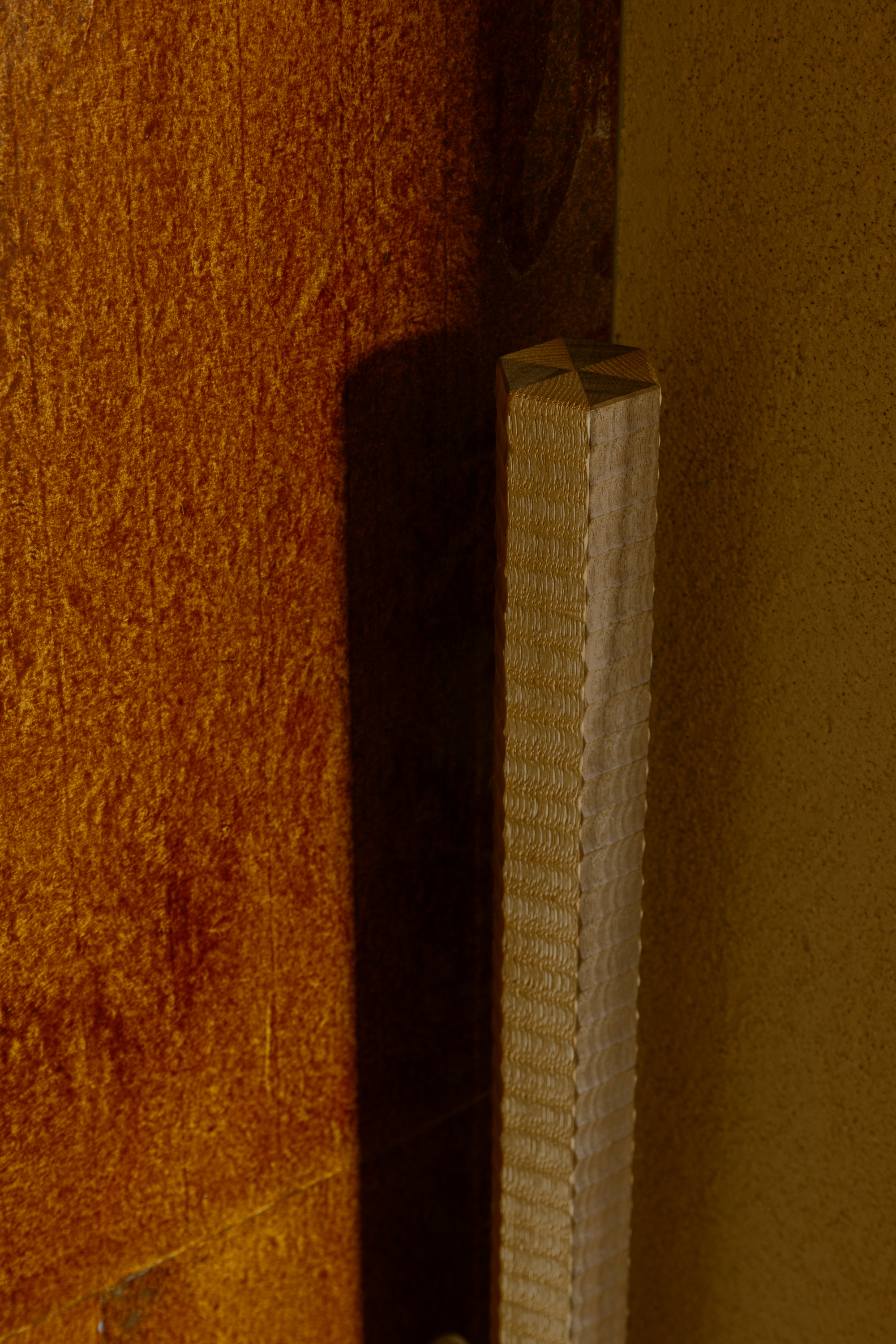
从玄关上来之后,地板采用了经过名栗加工的实木材料,不仅在视觉上呈现质感,更通过脚下的触感传递出归家的安心感。
At the top of the entrance step, flooring finished with the naguri carving technique is used, offering not only visual warmth but also a comforting tactile sensation underfoot—instilling a sense of homecoming from the ground up.
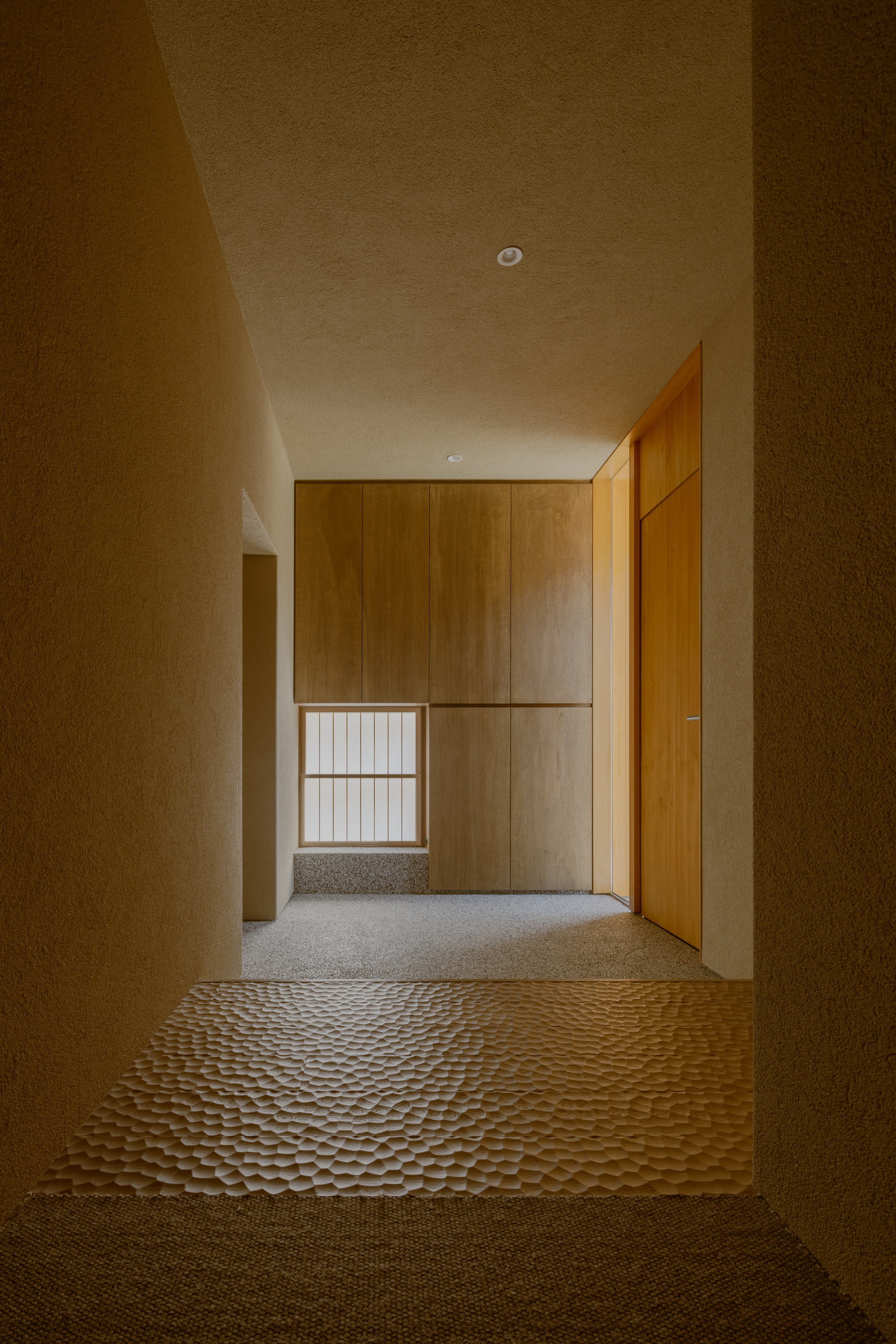
楼梯处柔和的自然光从北侧上方洒入,贝松实木的踏板、铜色的扶手,以及工匠细心缠绕的藤制扶手的质感,共同营造出温馨柔和的空间氛围。
Soft natural light filters in from the upper north side of the staircase, gently illuminating the space. The solid Douglas fir treads, copper-toned handrail, and the finely hand-wrapped rattan railing by skilled craftsmen all contribute to a warm, enveloping atmosphere through their rich textures and natural materials.
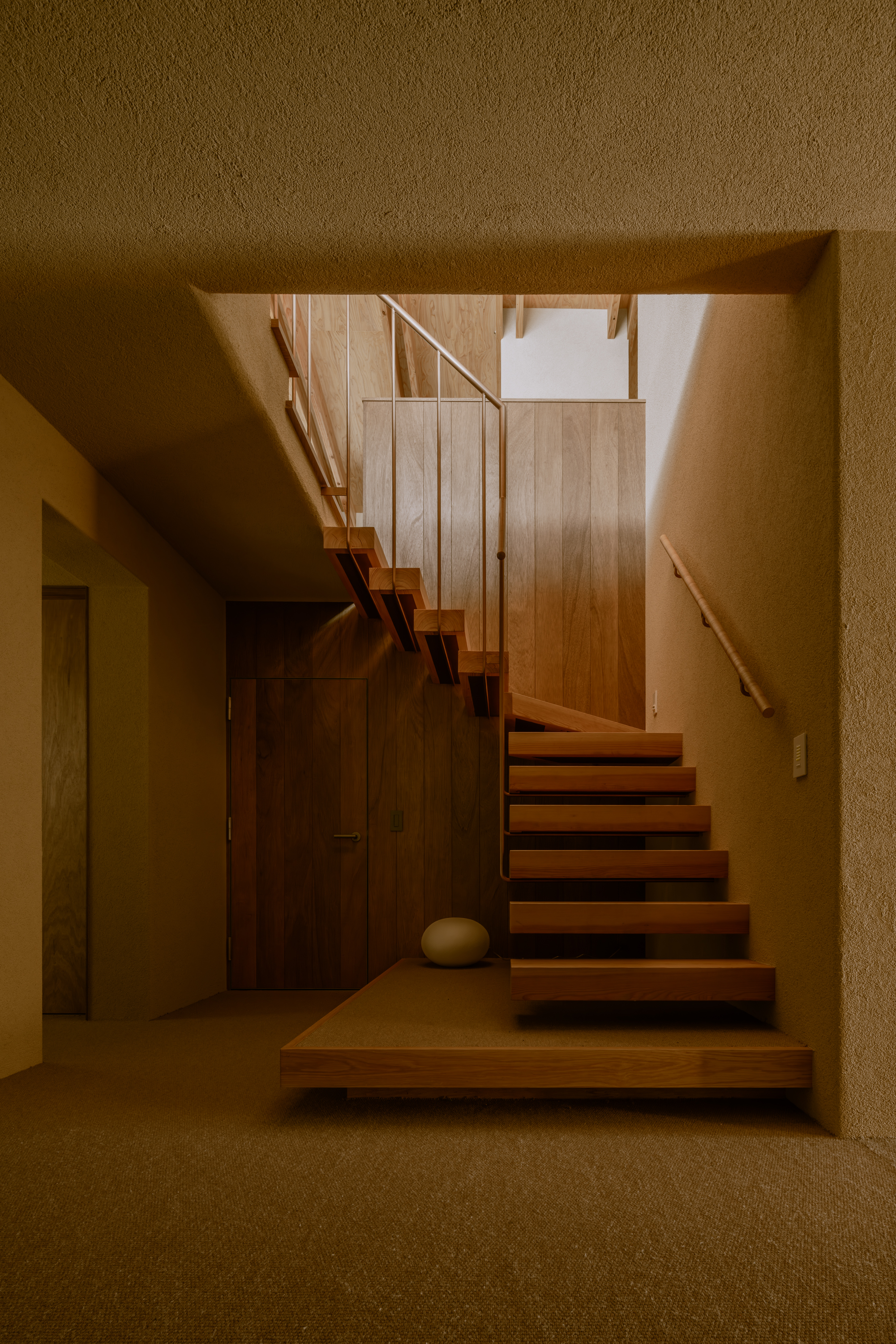
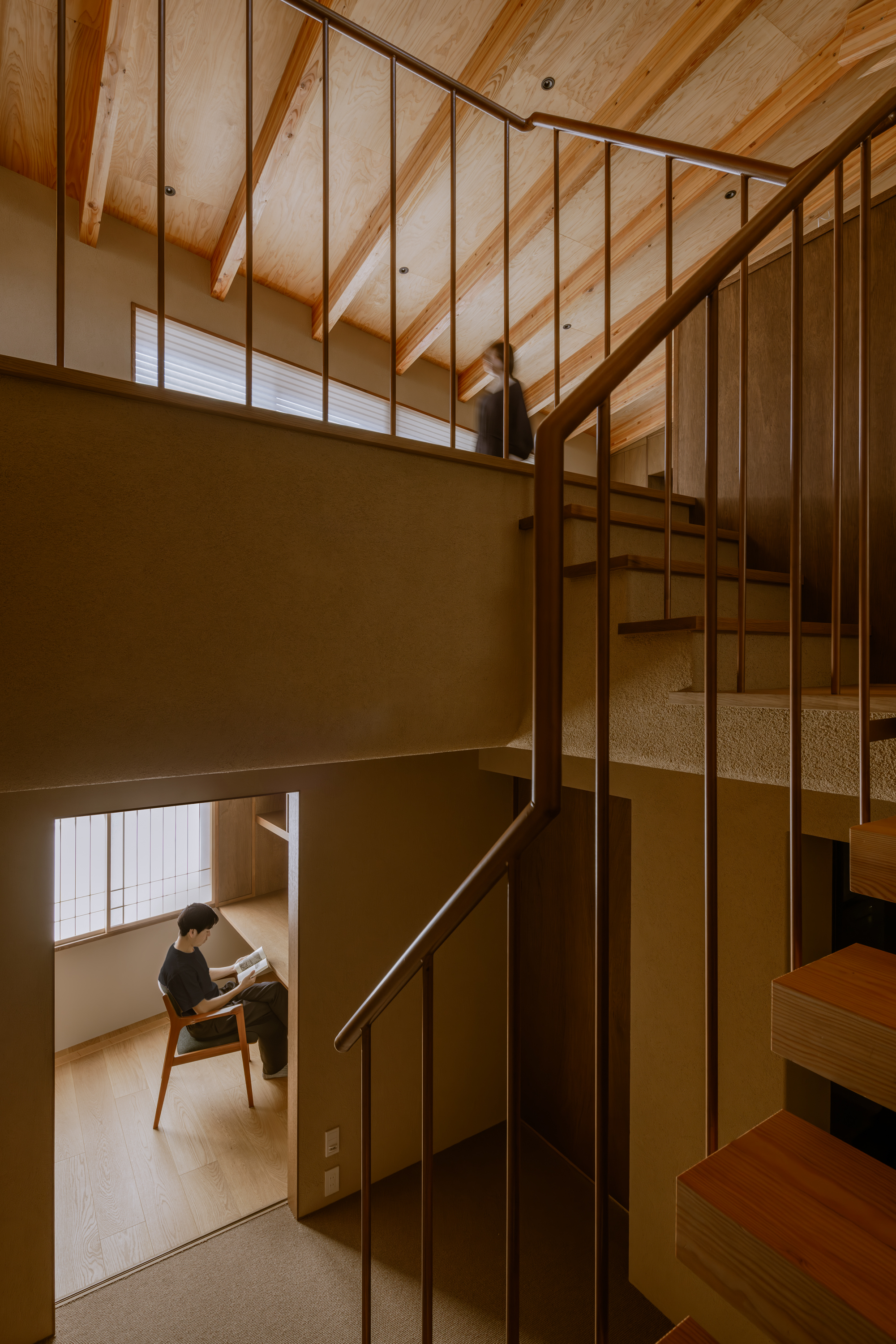
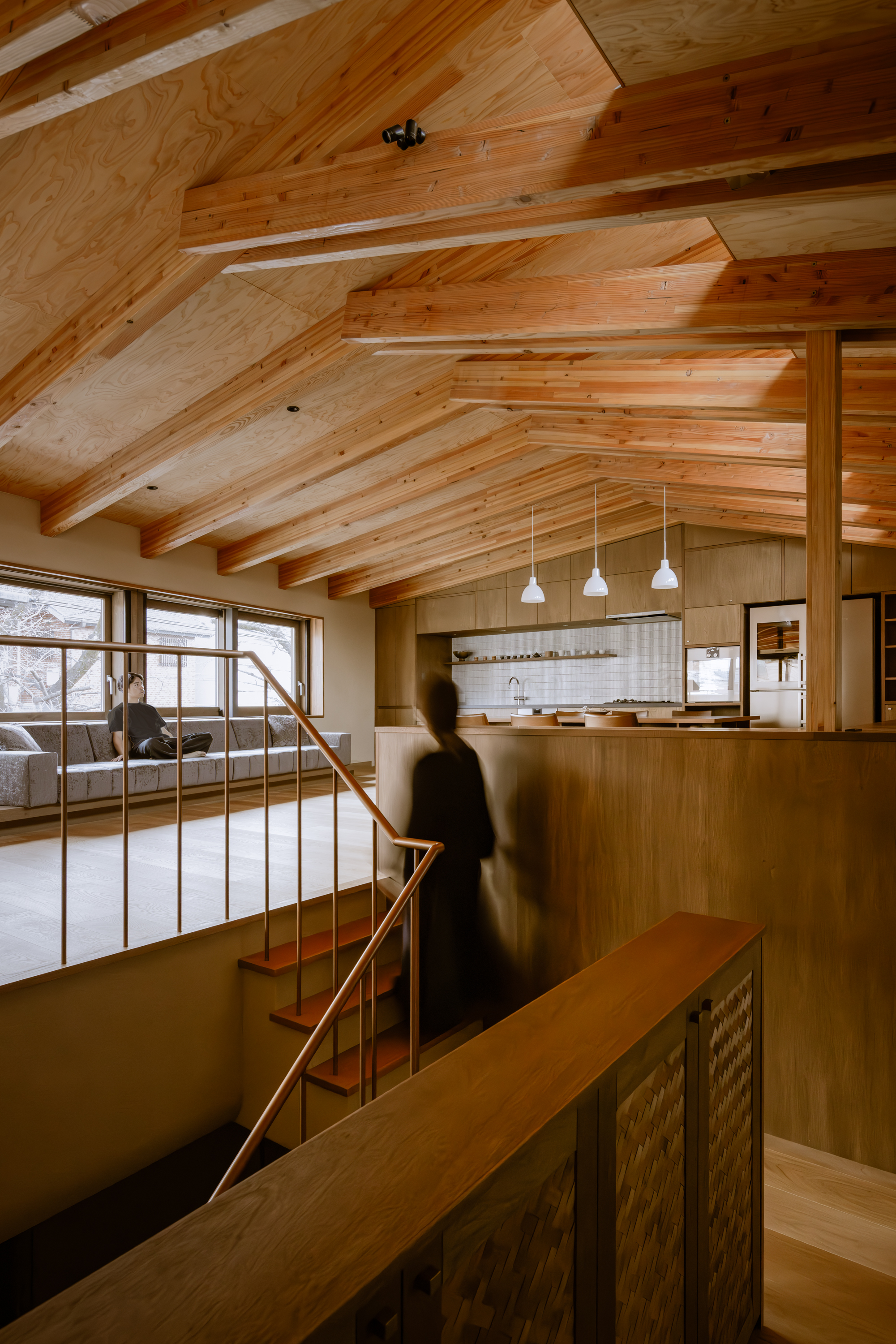
居住中最长时间使用的客厅、餐厅和厨房(LDK)被安排在二楼南侧,面向樱花林道,拥有超过13米的宽阔开口。
The living, dining, and kitchen area—where the family spends the most time—is placed on the south side of the second floor, offering a view of the cherry tree-lined street through a frontage of over 13 meters.
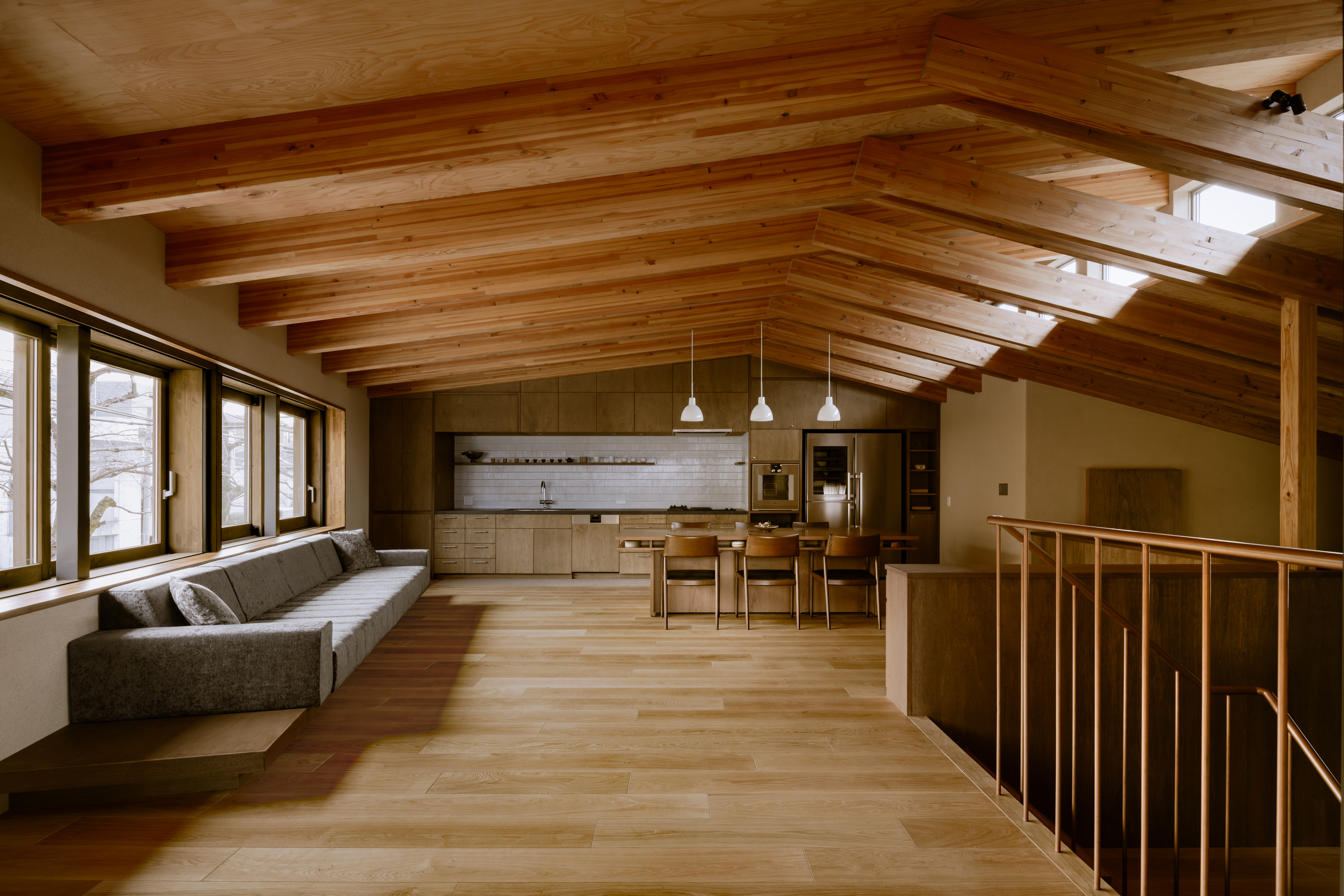
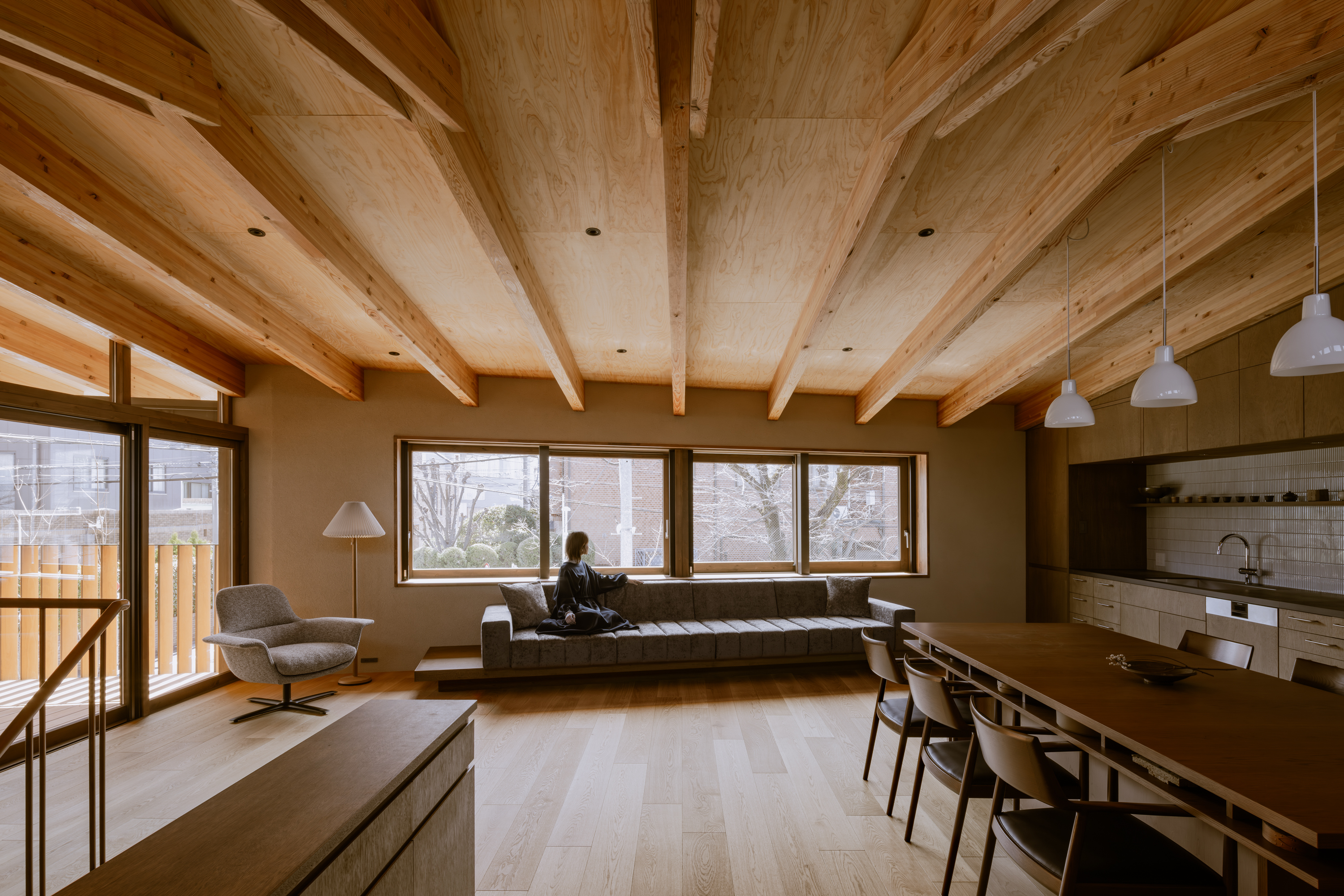
为了让五口之家宽敞自在地生活,我们设计了无柱结构空间。通过避免在大梁的垂直方向设置小梁,使来自北侧天窗的自然光能够柔和地洒满天花板,整个空间在一天中都能充满自然光线。
To allow a family of five to live comfortably and openly, the structure was designed as a column-free space. By avoiding the use of secondary beams perpendicular to the main beam, natural light from the skylight on the north side spreads gently across the ceiling, creating a space that can be enjoyed throughout the day in natural light.
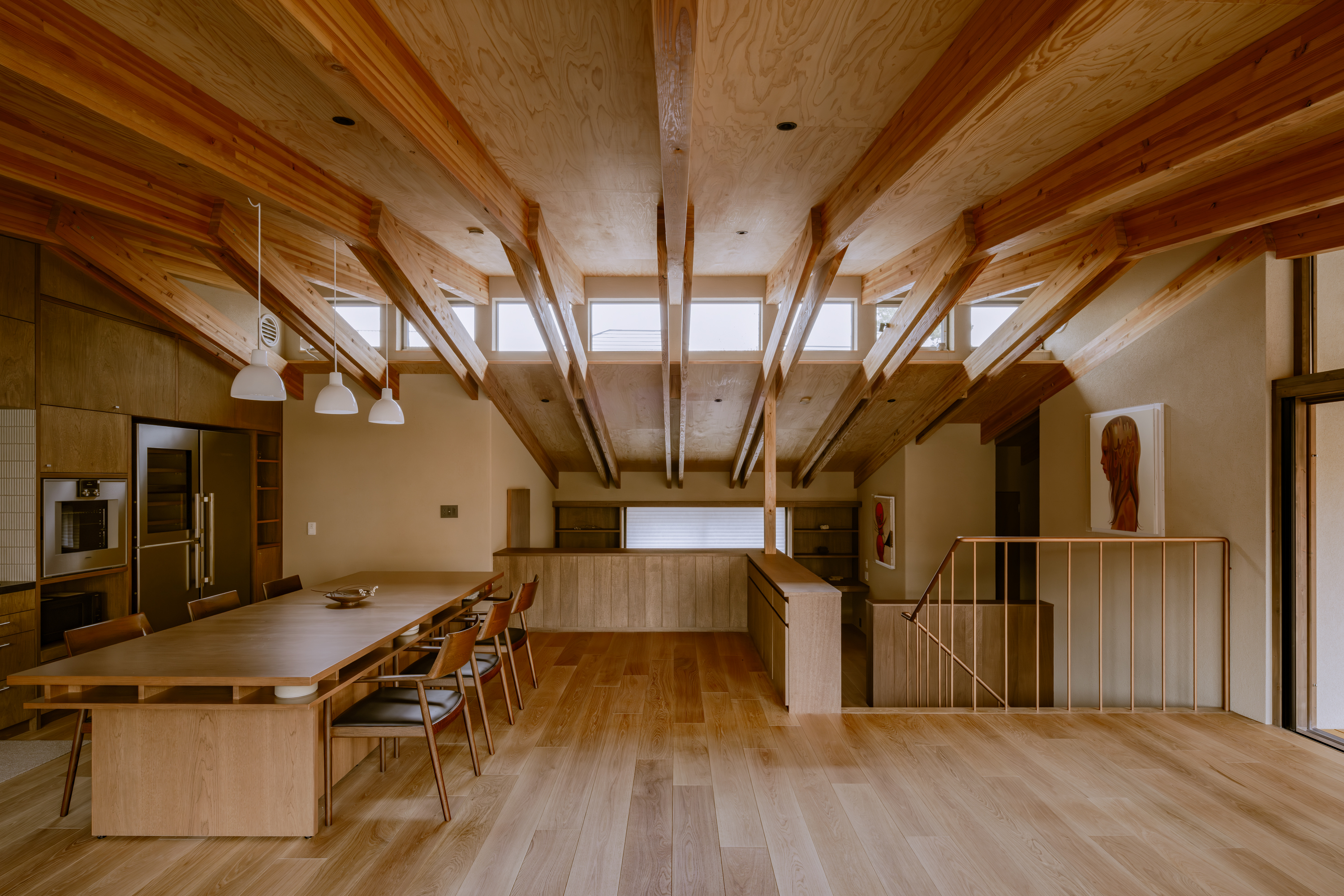
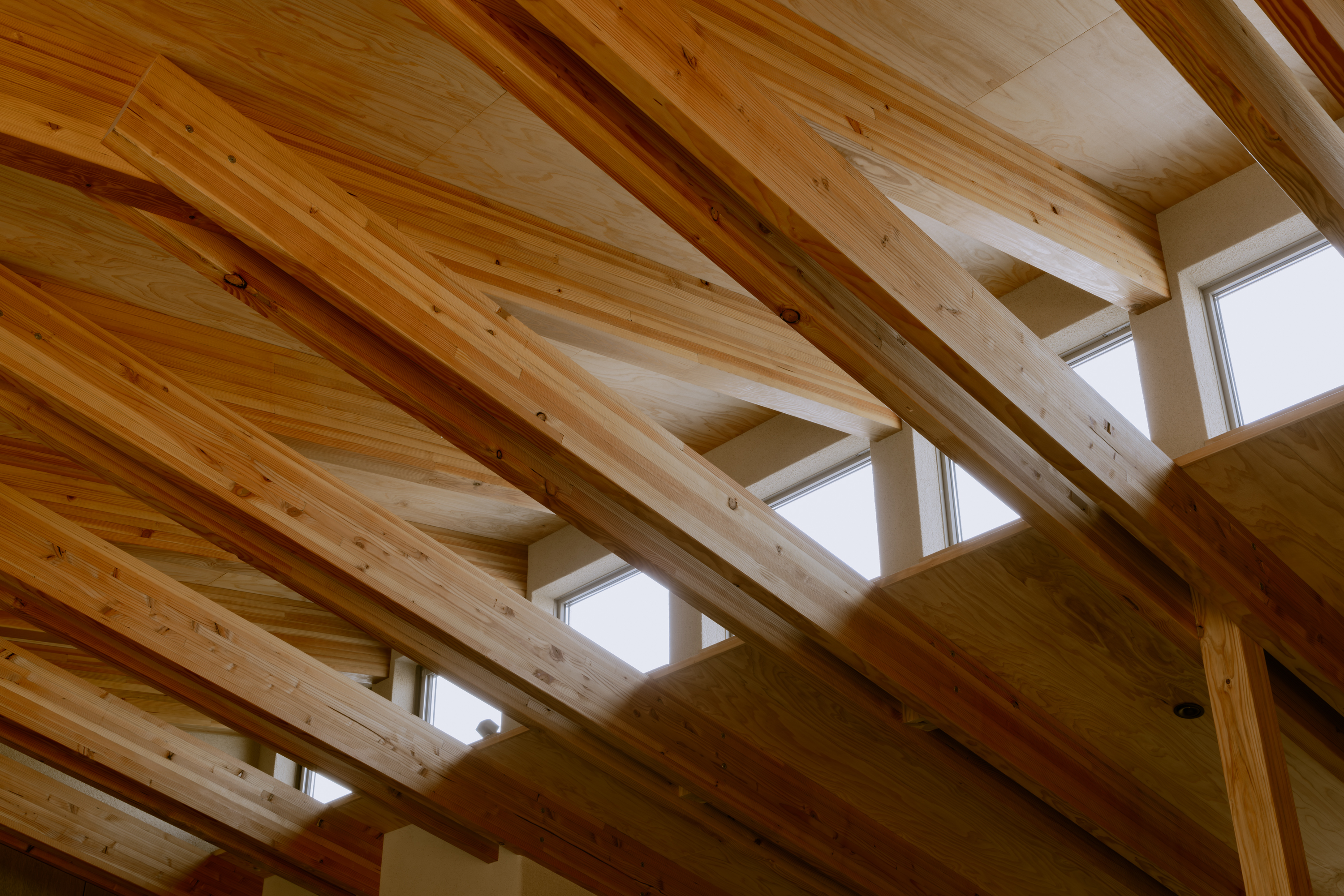
为了实现最大12米跨度(客厅餐厅跨度为7.7米)的木结构无柱设计,我们采用了将105×270毫米的大梁夹着半割的60×240毫米梁,按910毫米的间距组成剪刀式桁架(Scissors Truss);在与其垂直的天窗部分则设置维尔恩德尔桁架(Vierendeel truss)。通过这种设计,水平力由同时作为饰面层的屋面板承担,从而形成了无小梁、结构规整且坚固的大屋顶。
To achieve a column-free wooden structure with spans of up to 12 meters (7.7 meters across the living-dining area), a scissor truss system was employed. This consists of 105×270 mm main beams sandwiched by halved 60×240 mm members, arranged at 910 mm intervals. At the intersecting skylight area, a Vierendeel truss is incorporated, enabling the roof to resist horizontal forces using only the sheathing boards, which also serve as the finished ceiling. The result is a clean, refined, and robust large roof without the need for secondary beams.
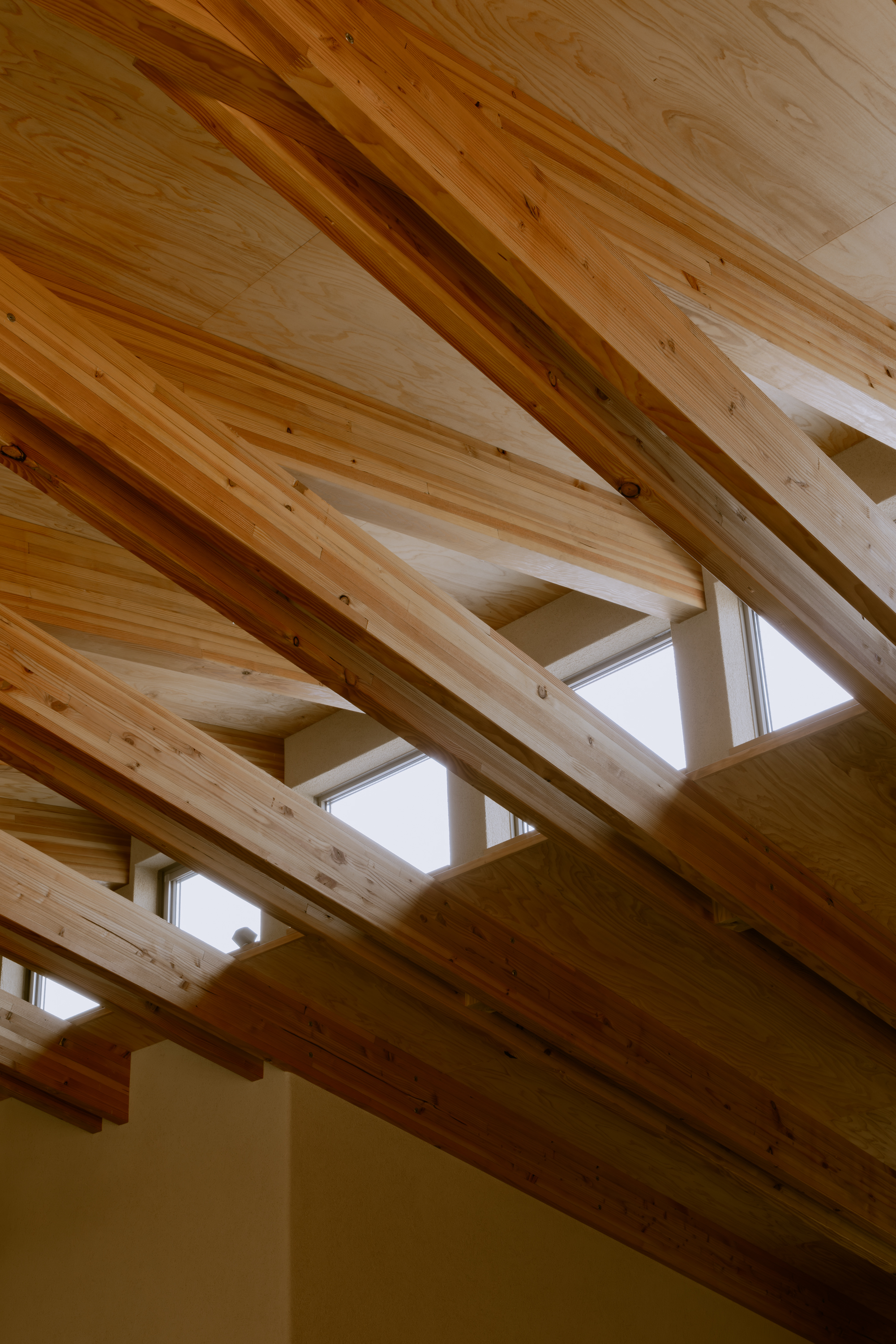
环境设计方面,以被动式节能设计为基础,建筑结构通过檐口和墙体遮挡阳光直射,具备充分的隔热性能,最大化利用自然通风和自然采光。
From an environmental standpoint, the design is based on passive principles, incorporating deep eaves and wall configurations to block direct sunlight, along with high insulation performance to ensure thermal comfort. Natural ventilation and daylight are maximized throughout the home.
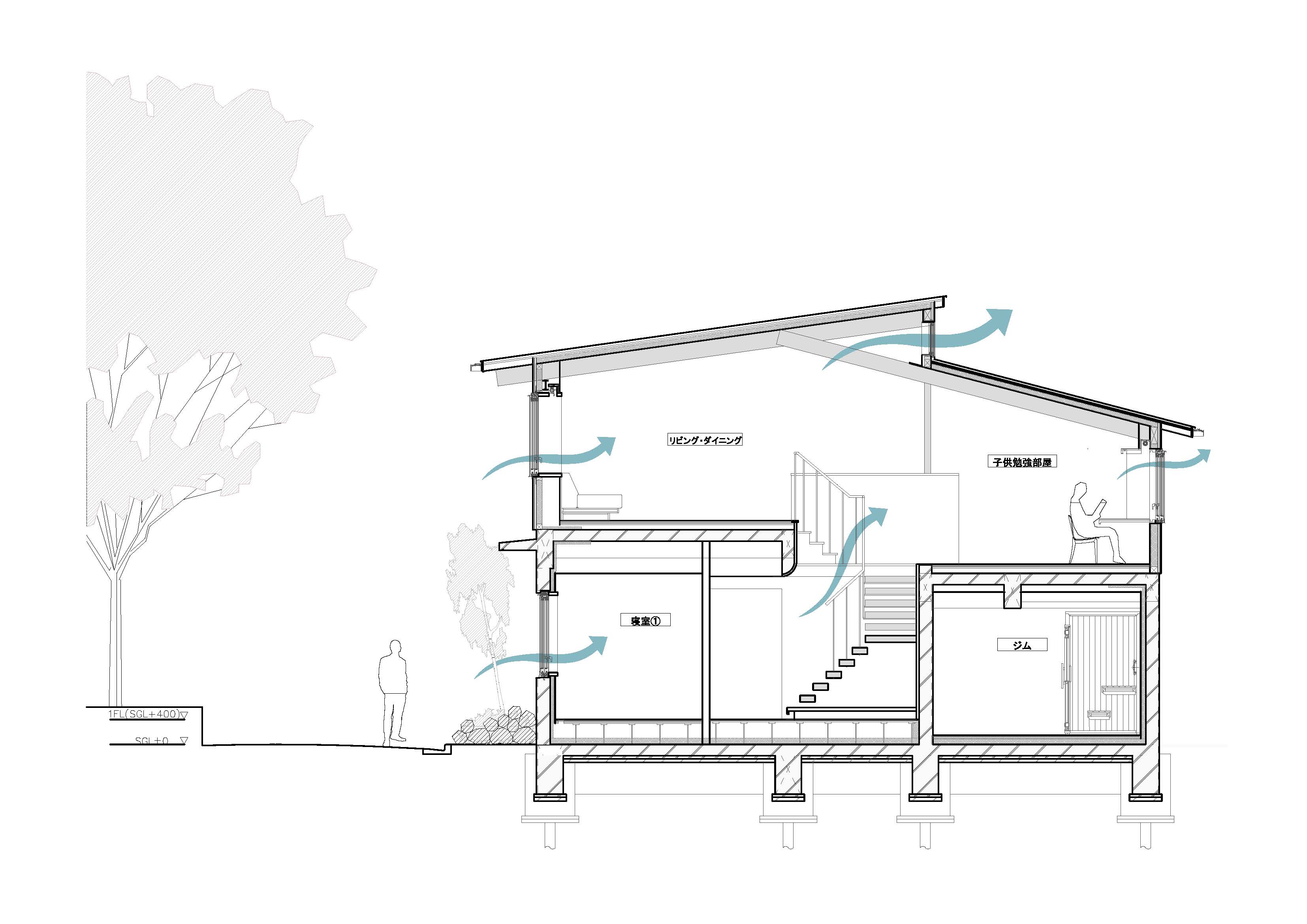
一、二楼南侧均设有大面积开口,引入南北方向稳定流动的风,同时结合重力通风原理,开启屋顶顶部的天窗,从一楼吸入风的气流,实现自然通风效果。
Large openings are placed on the south side of both the first and second floors to capture prevailing north-south breezes. Additionally, by utilizing stack ventilation, opening the skylight at the roof's peak creates an upward airflow that draws in air from the ground floor—establishing a natural and efficient system of ventilation throughout the building.
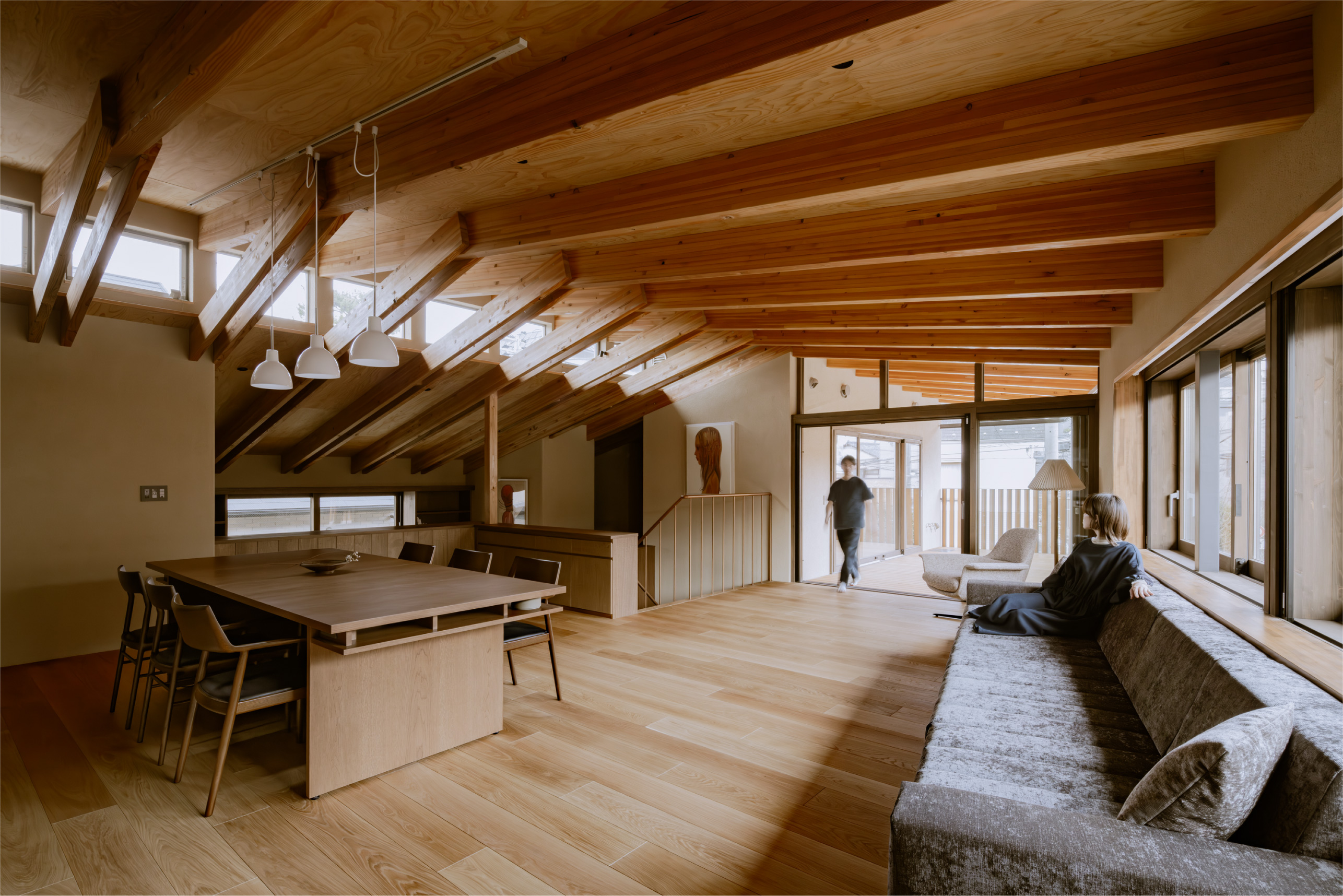
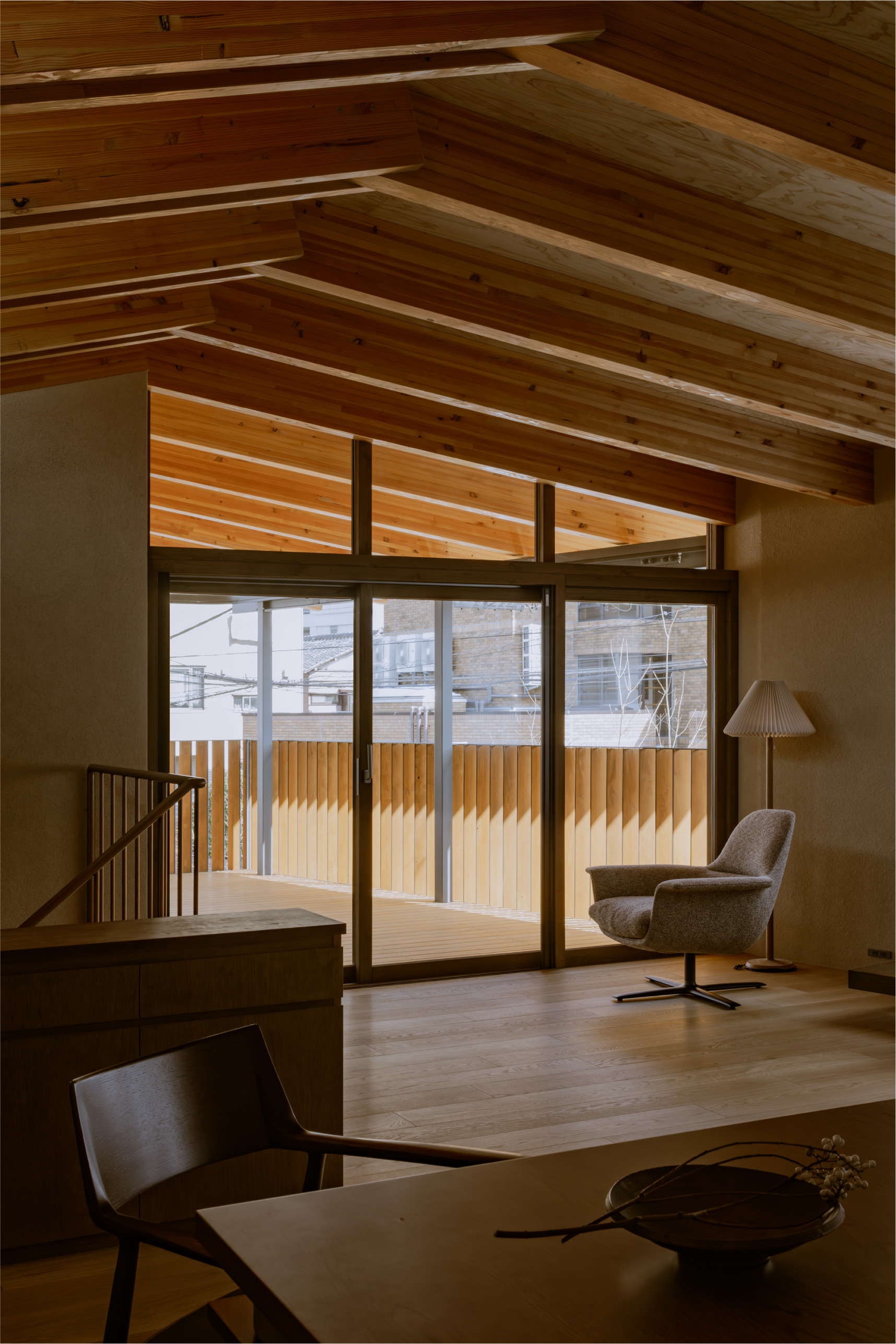
在寒冷季节,设计通过吸取屋顶顶端积聚的暖气,送至一楼窗下及浴室等较冷区域,使暖气在整个房屋内循环流动。
In winter, the design allows warm air that accumulates at the roof’s peak to be drawn in and directed to colder areas such as beneath first-floor windows and the bathroom. This creates a circulation of warm air throughout the house, helping to maintain a comfortable indoor temperature and reduce cold spots.
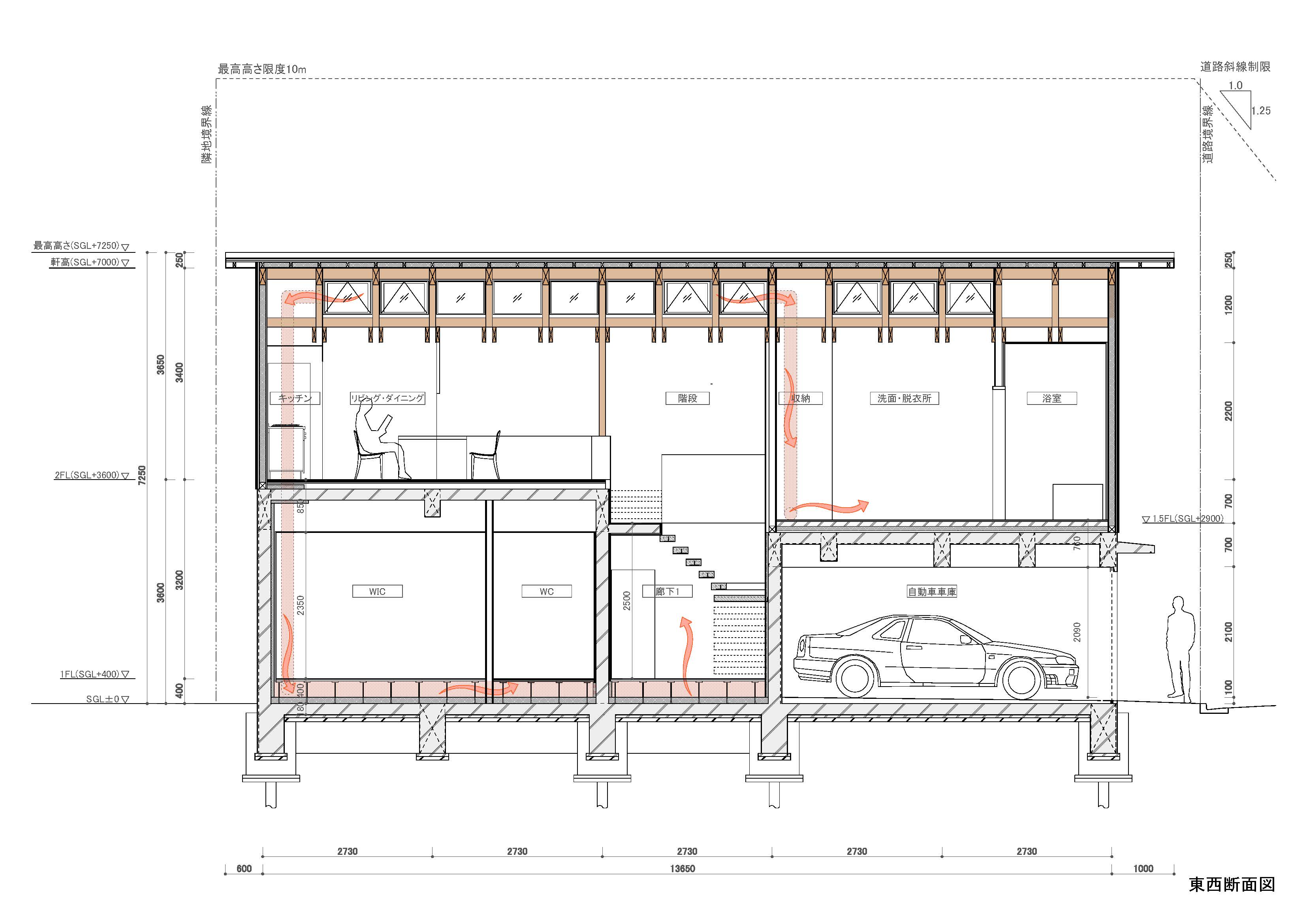
在客厅、餐厅和厨房(LDK)与室外之间设置了无缝连接的露台,拓展了起居空间的延展性。保持面向樱花林的开放视野的同时,也设计了可调节视线遮蔽度的窗帘,以满足夜间对隐私的需求。白天透光的布料随风轻盈飘动,夜晚则通过增加布料密度形成不透明的隔断,使露台与LDK融为一体的空间感得以延续。
A terrace is positioned to seamlessly connect with the LDK, extending the living space outward. To maintain openness toward the cherry tree-lined street while also addressing nighttime privacy, custom curtains were designed. During the day, the light, translucent fabric gently sways in the breeze, preserving a sense of openness. At night, the fabric's density increases to create a more opaque boundary, allowing the terrace to become an integrated, private extension of the LDK.
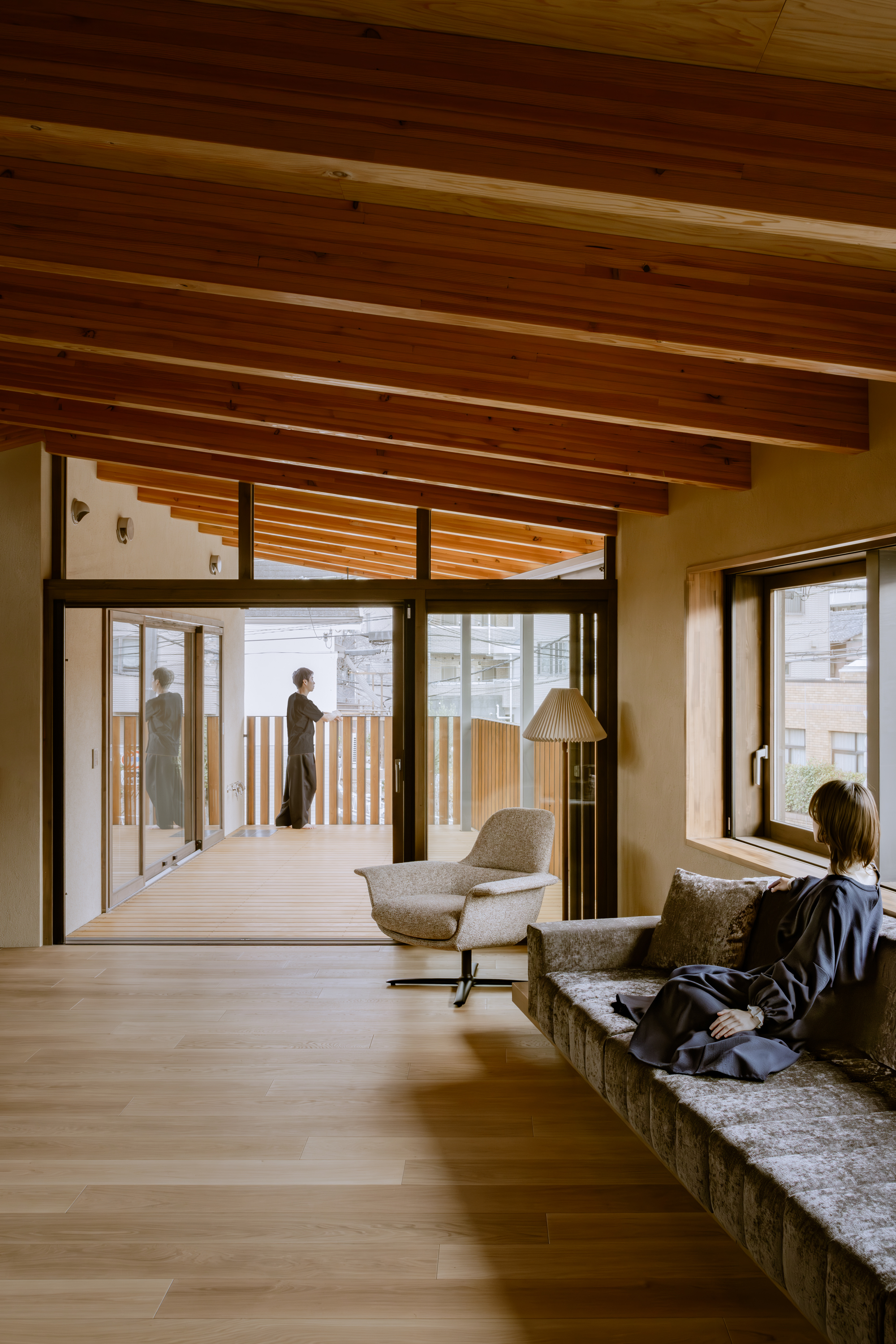
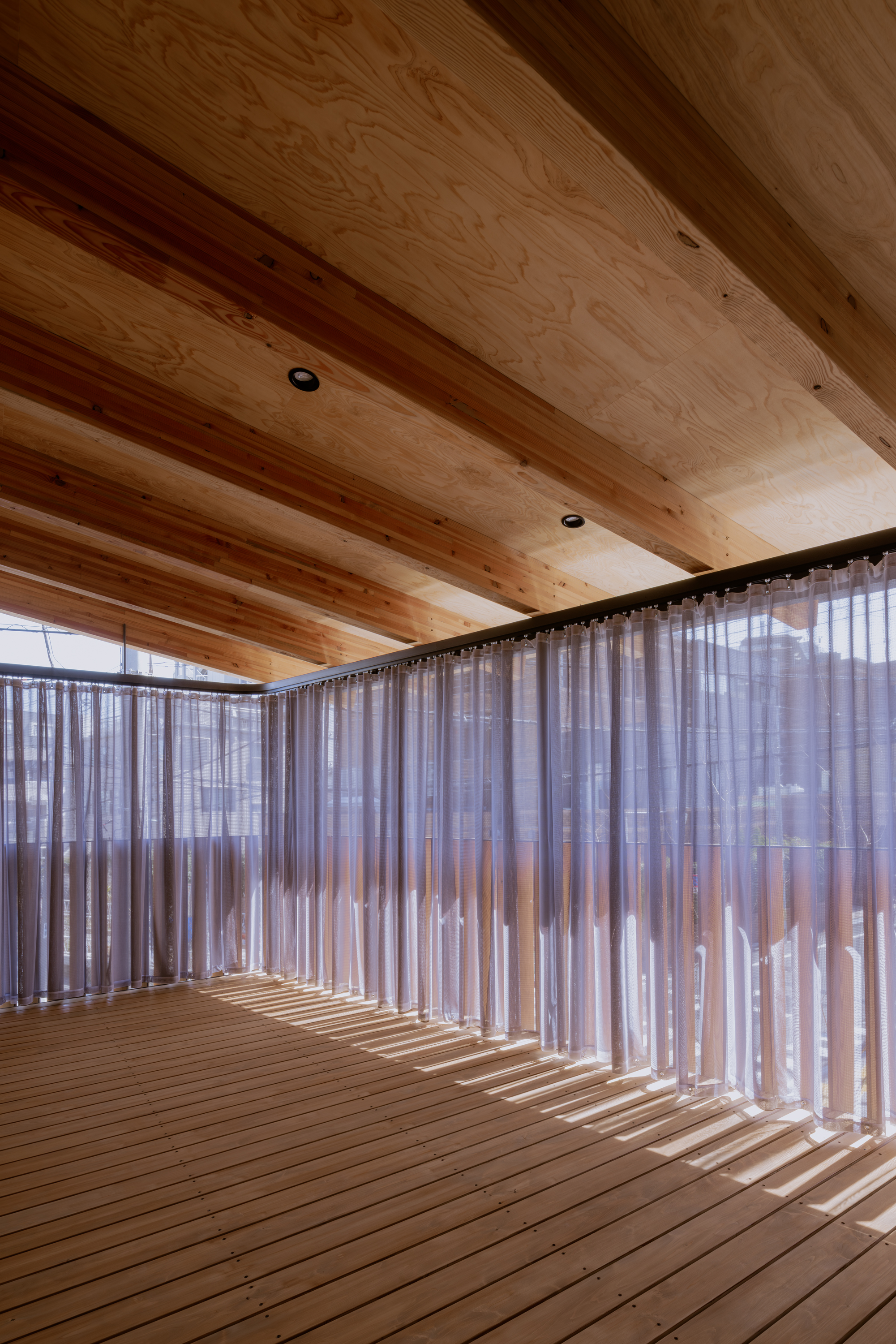
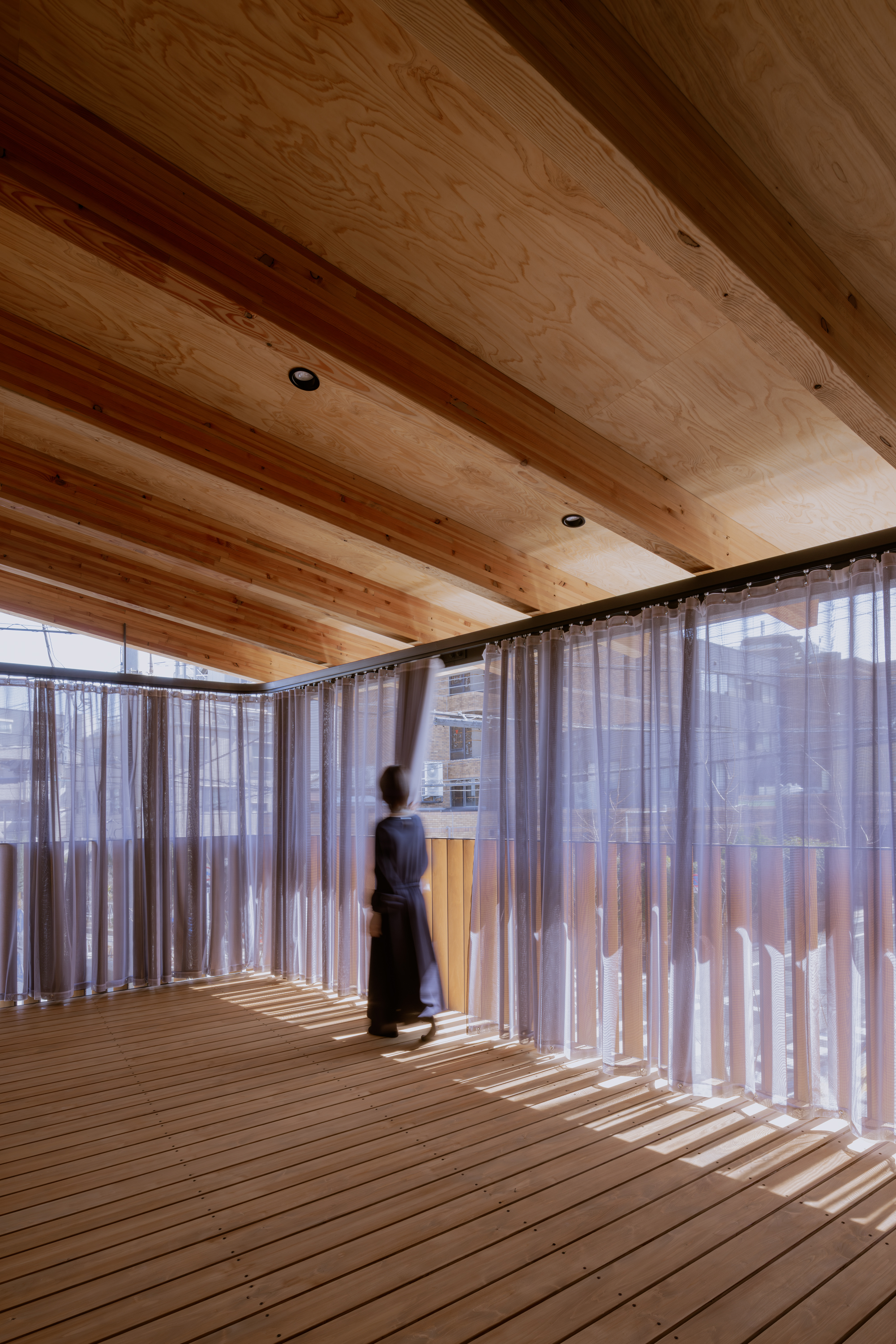
浴室紧邻露台布置,脱衣室和浴室内也能洒入柔和的自然光,并且设计得让人能够感受到微风。通过将浴室楼层降低于露台水平,有效阻隔了来自绿道的视线,同时保证了较高的天花板高度,使蒸汽能够顺畅上升并排出,避免积聚。
The bathroom is positioned adjacent to the terrace, allowing soft natural light and fresh air to flow into both the dressing area and the bathing space. By lowering the floor level of the bathroom relative to the terrace, the design blocks views from the greenway while securing a high ceiling. This not only provides privacy but also allows steam to rise and dissipate effectively, preventing it from lingering and creating a more comfortable bathing environment.
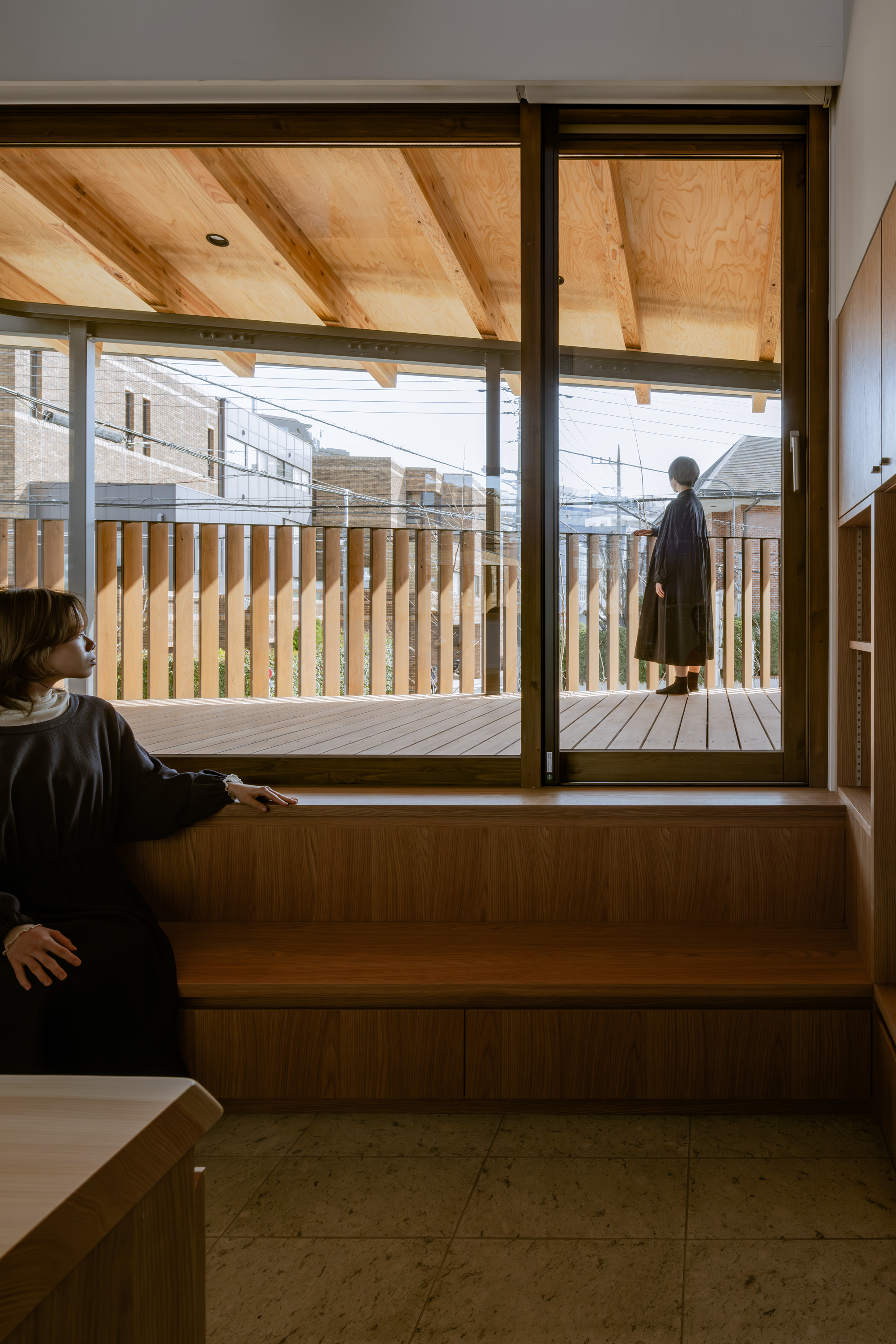
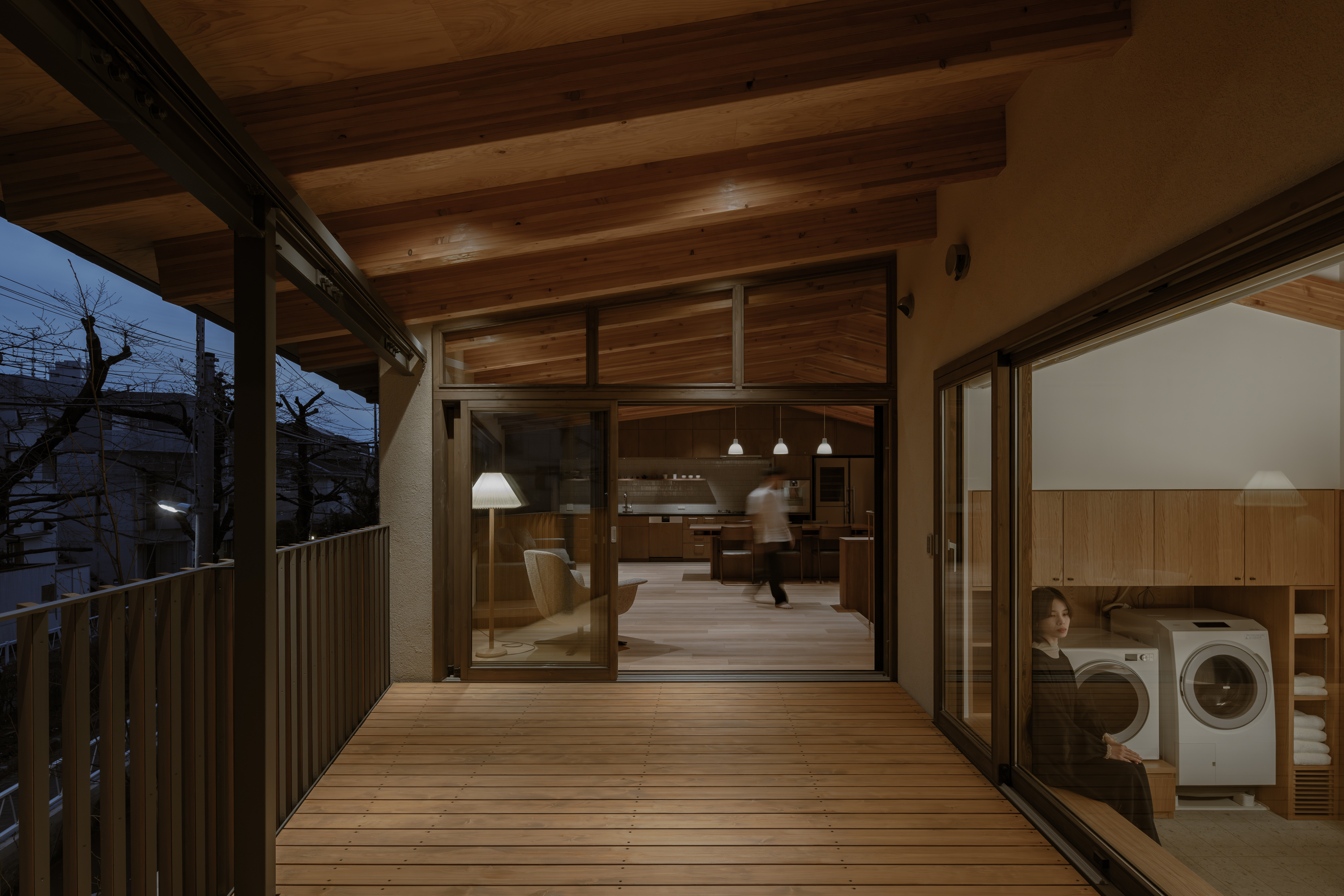
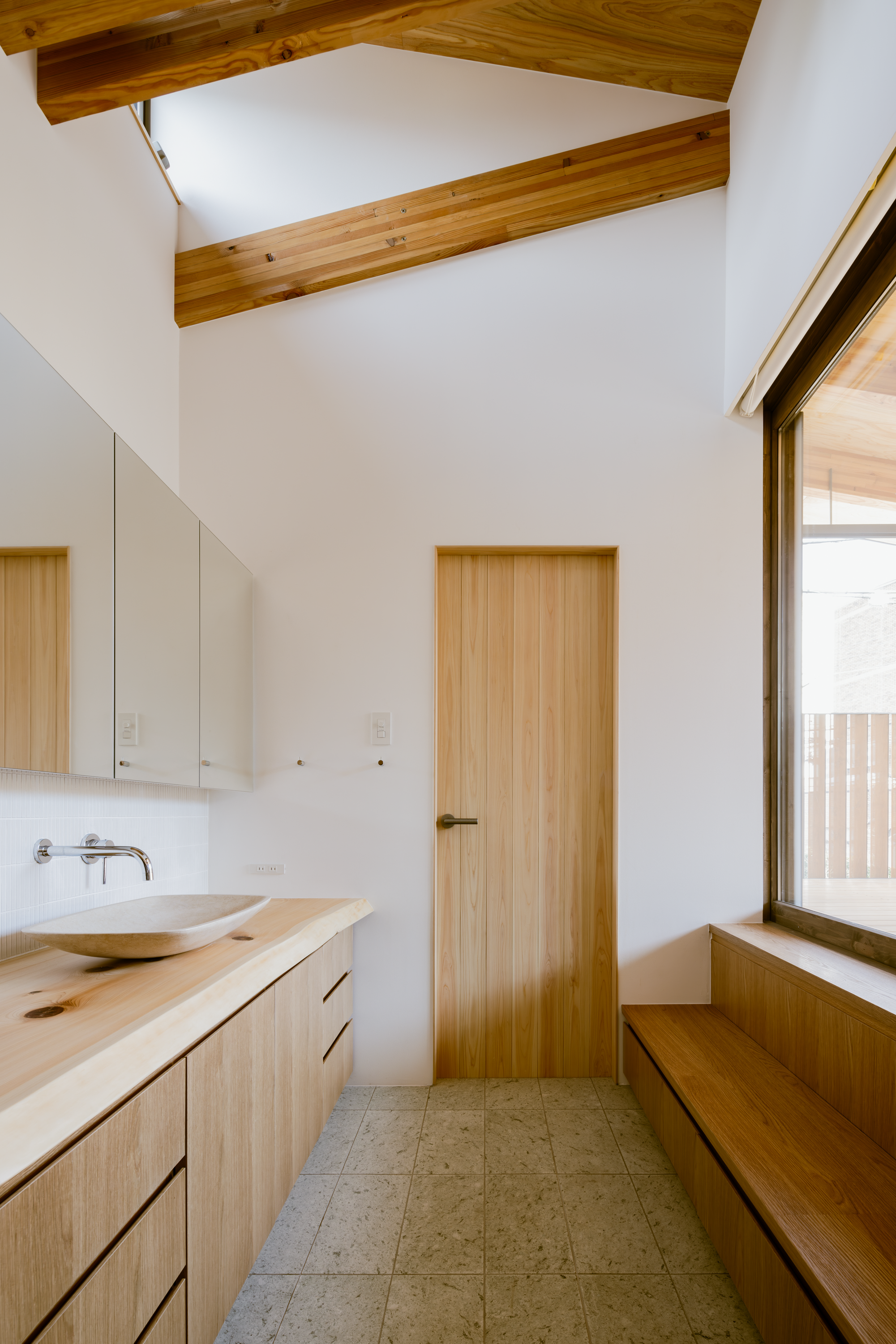
浴室采用十和田石与桧木,展现出丰富的肌理与色彩层次,并散发自然的芬芳。在沐浴时打开窗户,让四季之景随风入室,营造出一个能够温柔包容身心、予人疗愈的场所。
The use of Towada stone and hinoki cypress in the bathroom offers a rich sensory experience—through their varied textures, natural hues, and calming fragrances. With windows that open to the outdoors, the space is designed to allow one to bathe while feeling the changing seasons, creating a soothing retreat that nurtures both body and mind.
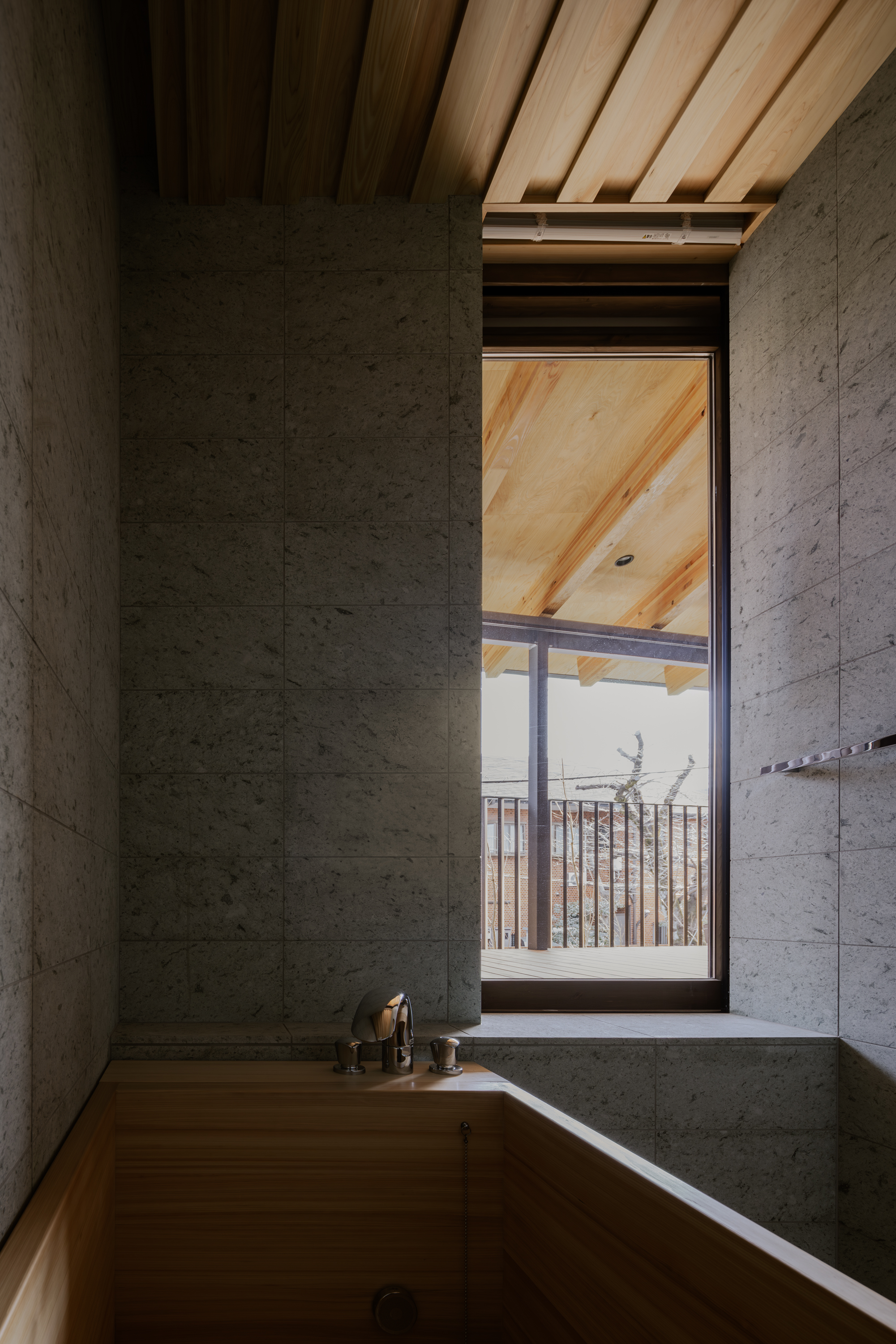
三个孩子的学习区并未作为独立的封闭房间设置,而是安排在跳层下沉约70厘米的空间中。这样既通过腰墙将其与LDK分隔开来,又能让空气流通,让家庭成员之间共享温馨的氛围,营造出既有区隔又互相连通的学习环境。
The study area for the three children is intentionally not enclosed as separate rooms. Instead, it is positioned about 70 centimeters lower than the LDK on a skip floor, creating a semi-separated space divided by a low wall. This layout maintains a sense of connection and shared atmosphere with the family, while still providing a dedicated zone for focused study.
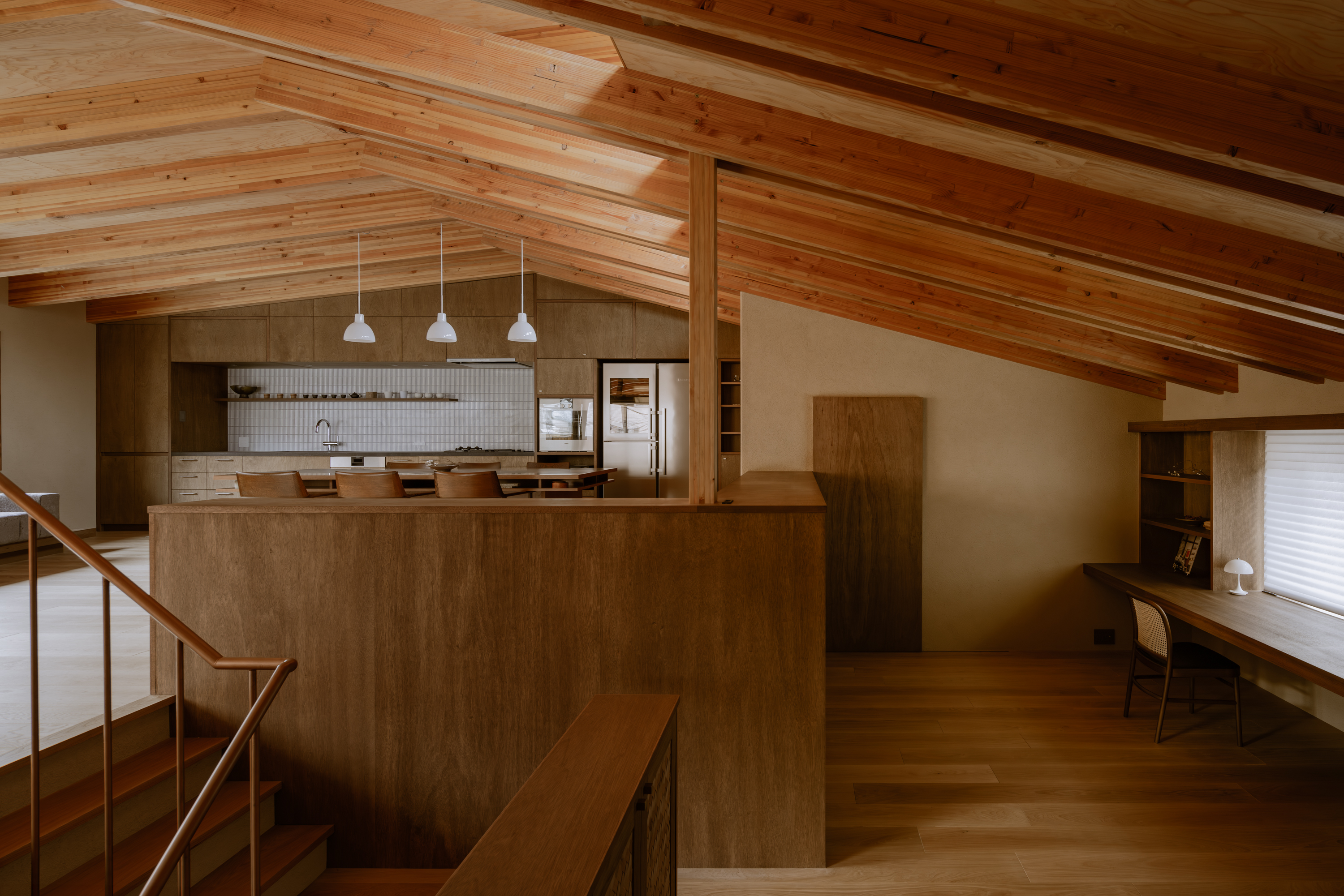
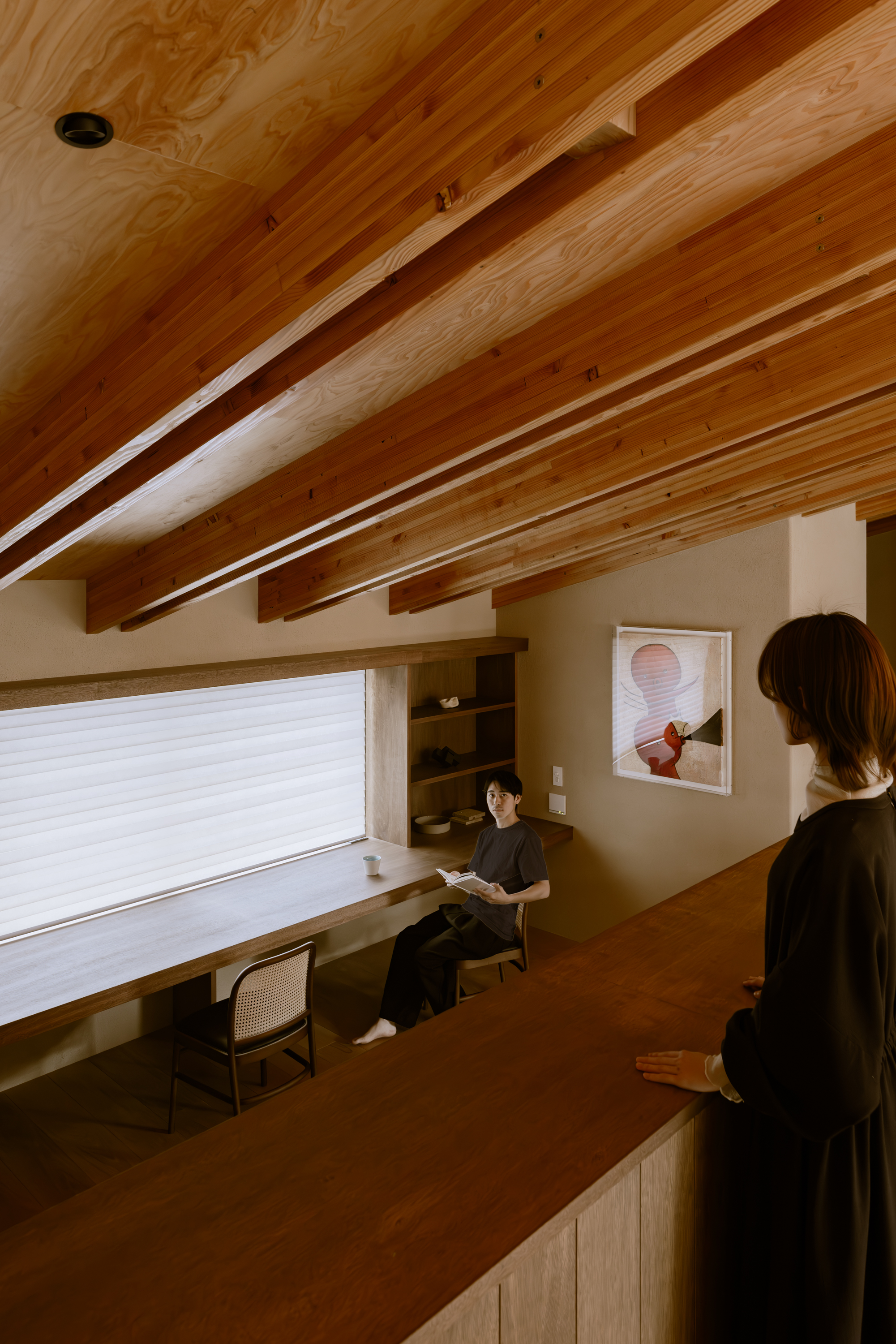
业主是一位随日出而起、日落而眠,生活与自然紧密相连的人,因此我们将卧室布置在朝阳温暖照射的东侧。障子柔和地扩散晨光,质感丰富的硅藻土墙面在四周环绕,这些都使自然光温柔地包裹整个房间。
The homeowner lives in harmony with the natural rhythms of the day—waking with the sunrise and resting as night falls. In response, the bedroom was placed on the east side, where the morning sun gently filters in. Shoji screens diffuse the sunlight softly, while the textured diatomaceous earth walls reflect and wrap the space in natural light, creating a serene and calming atmosphere to begin each day.
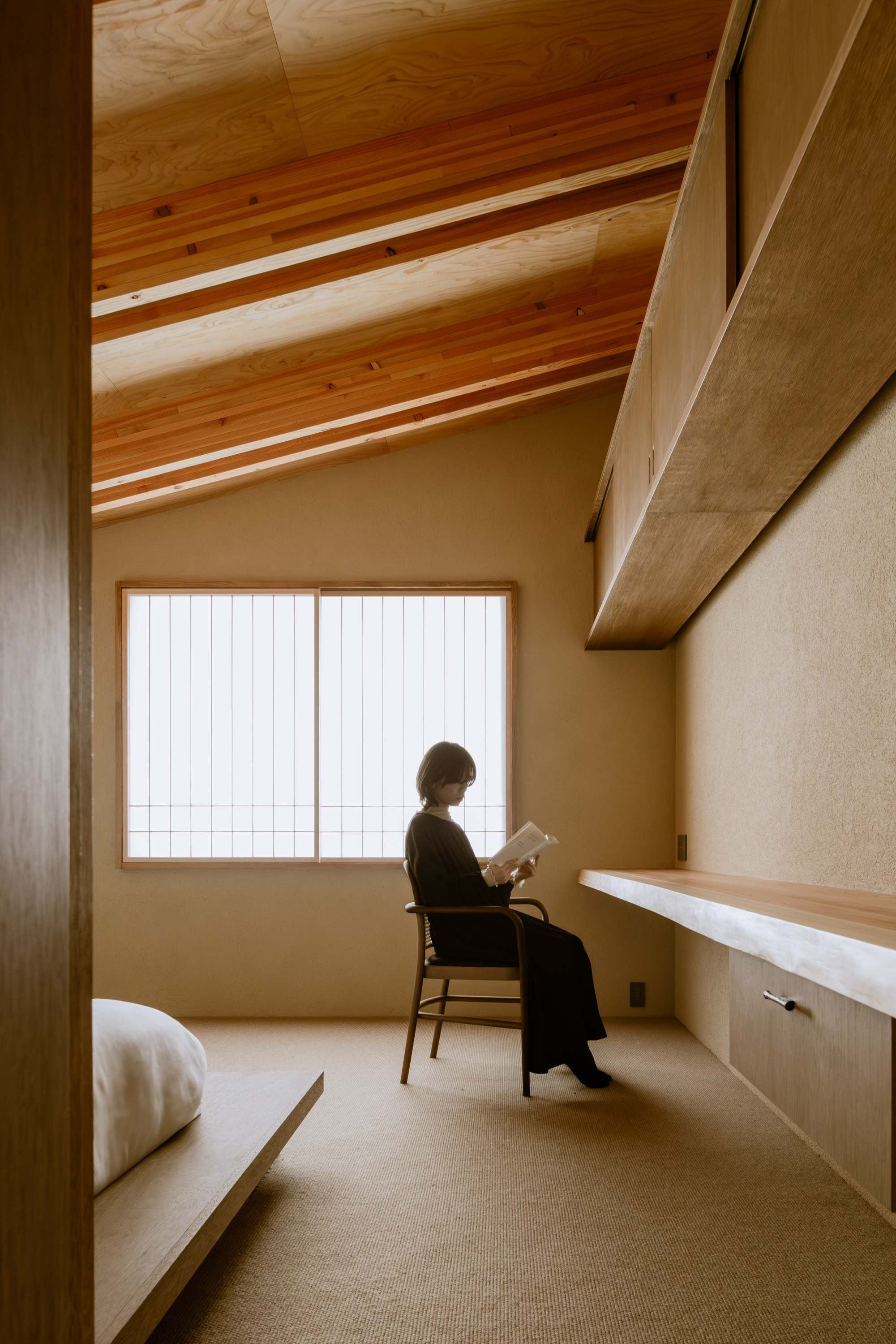
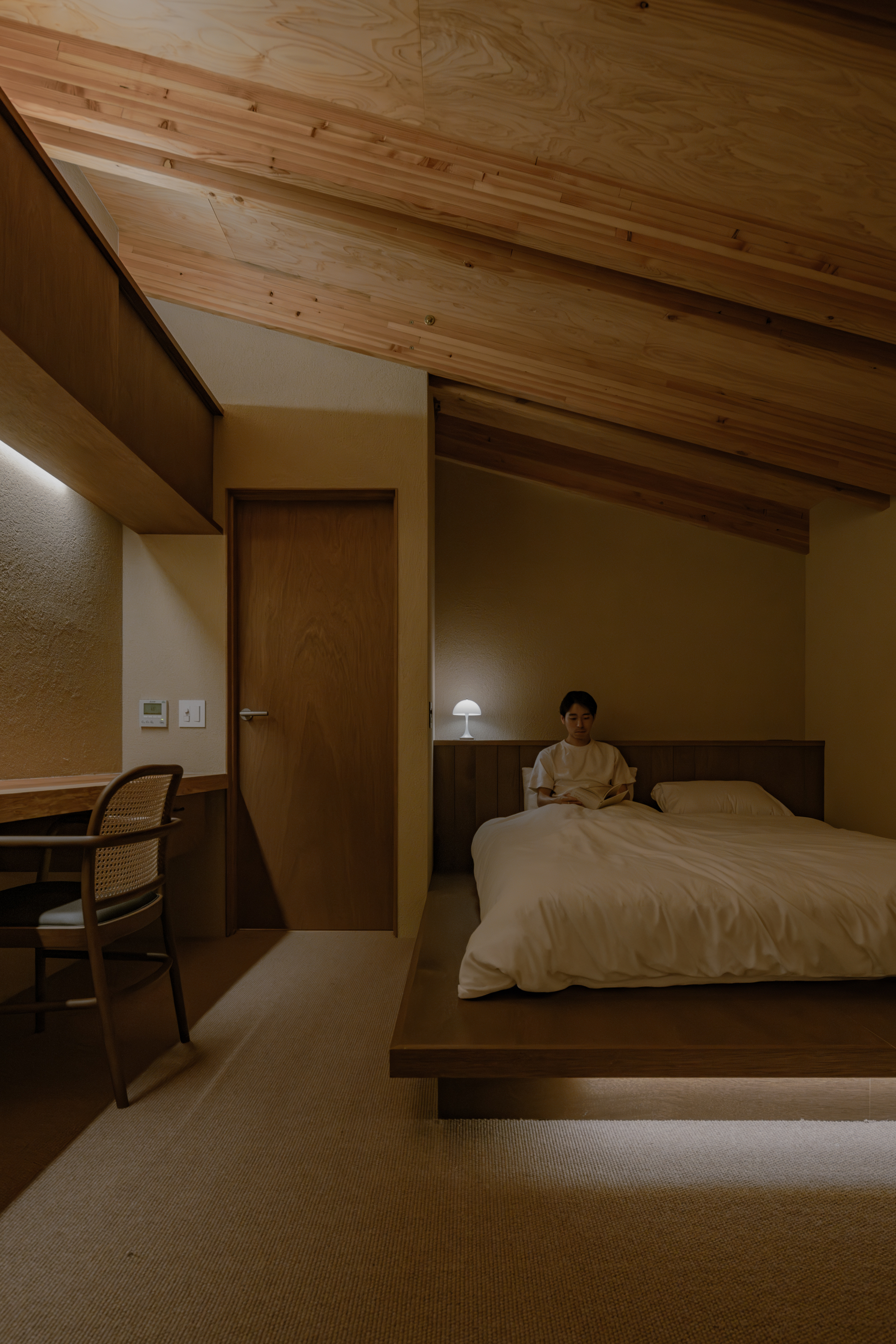
在充分享受外部自然环境恩惠的同时,室内也遍布自然素材,营造出充满工匠手工温度的空间。我们希望这所房子能随着岁月沉淀出独特的质感,见证家人宽厚而温暖的成长。
While fully embracing the blessings of the surrounding natural environment, the interior is adorned with natural materials that reflect the warmth of skilled craftsmanship. The space is designed to develop character and charm over decades, growing alongside the family and quietly witnessing their journey together.
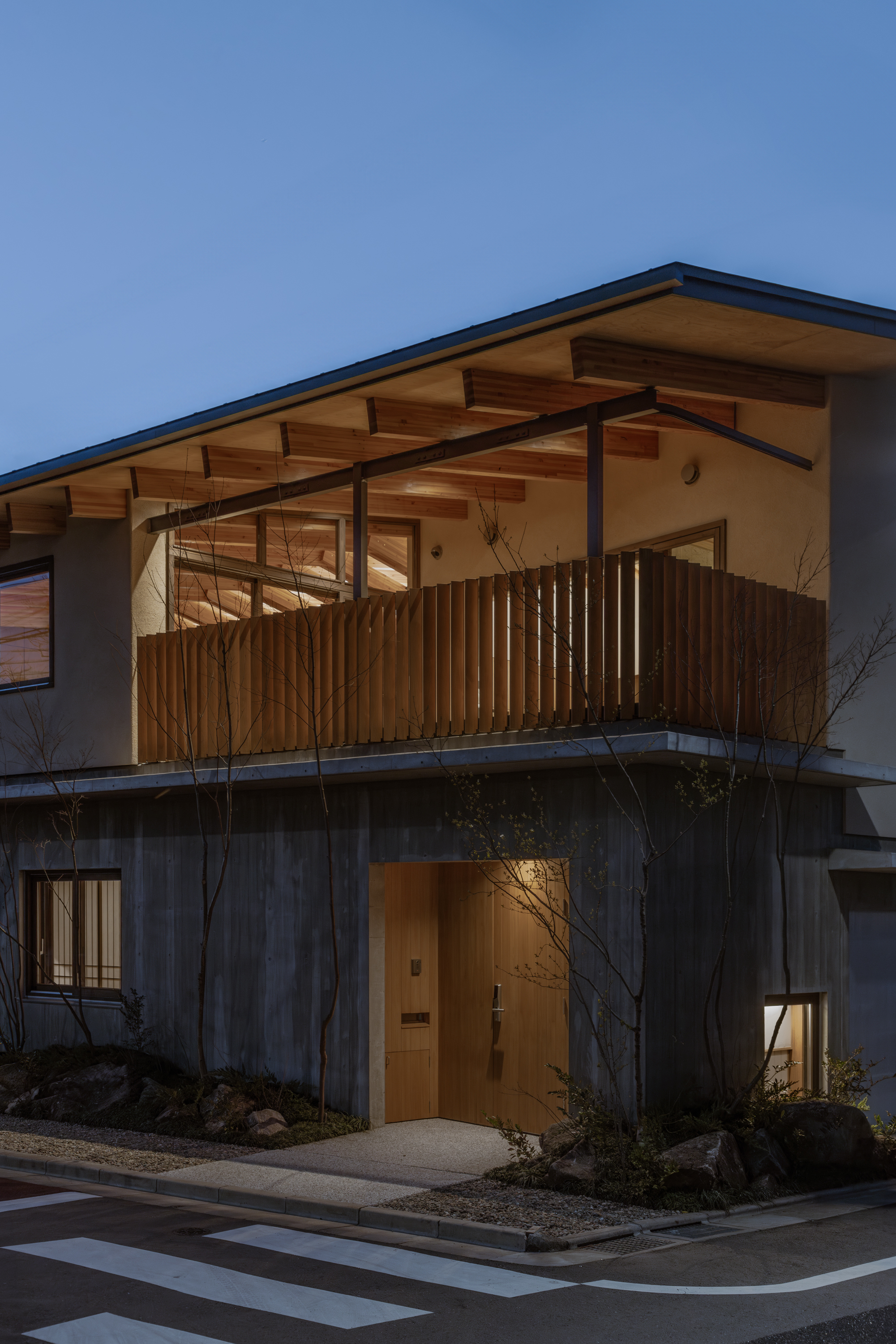
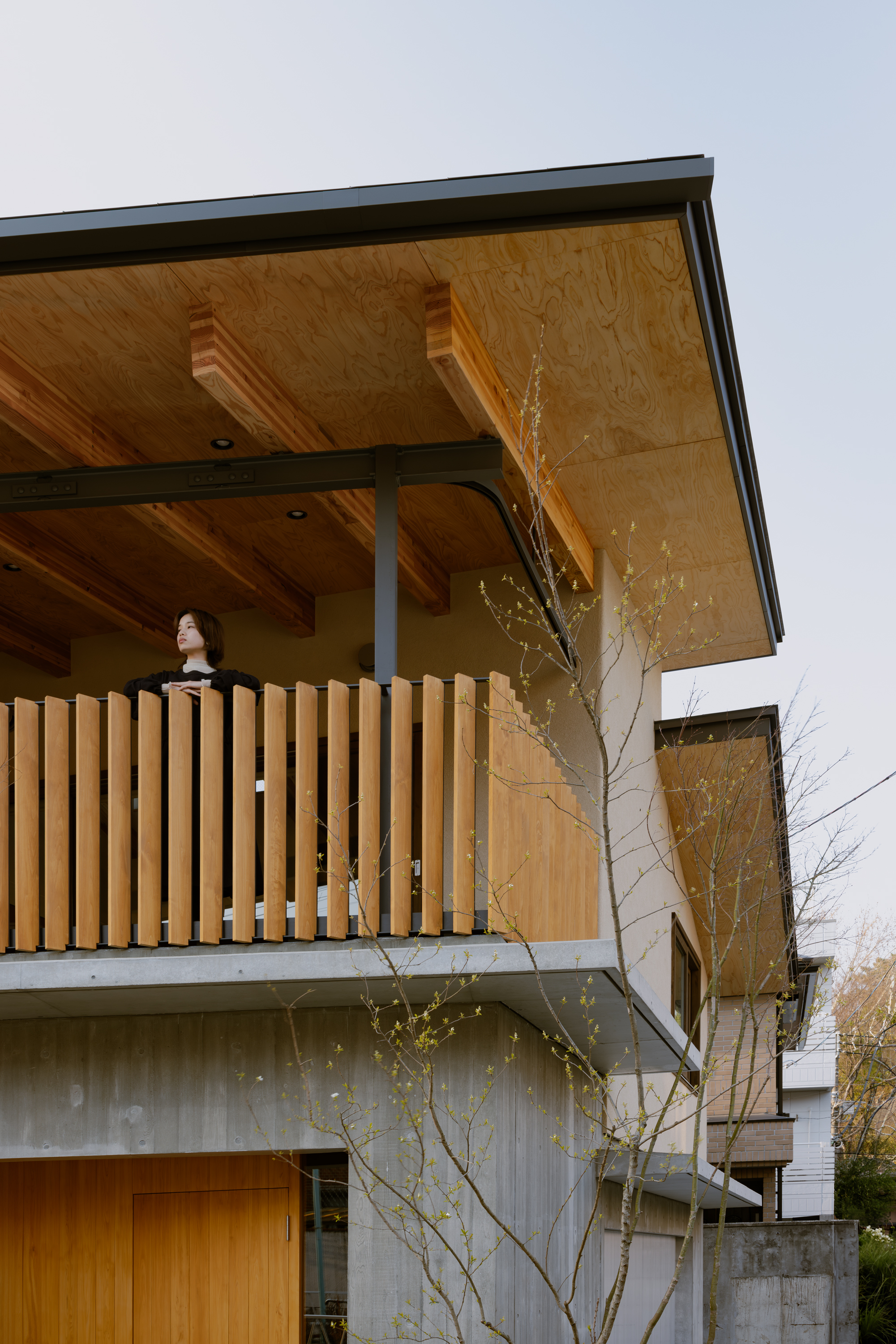

设计图纸 ▽
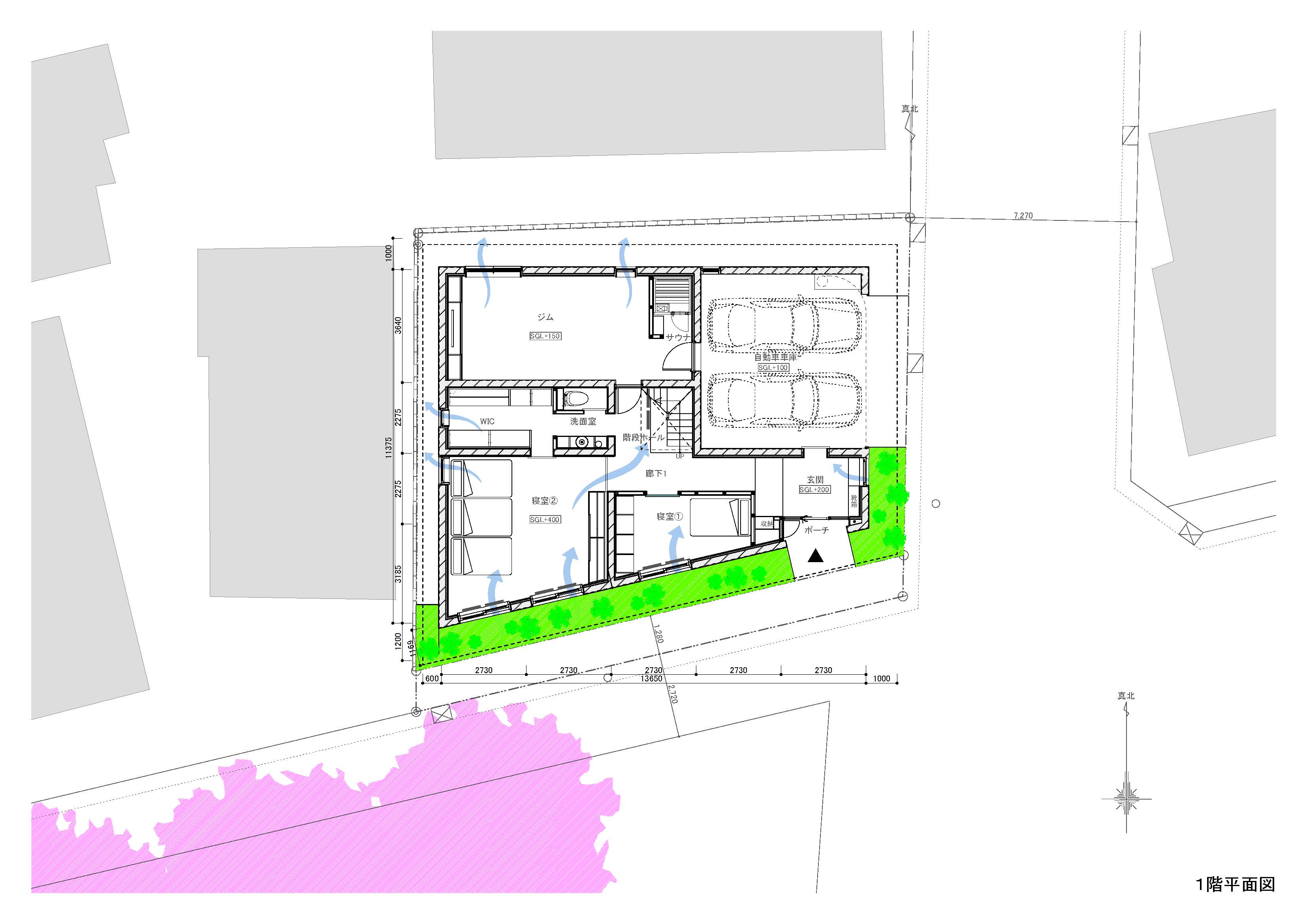
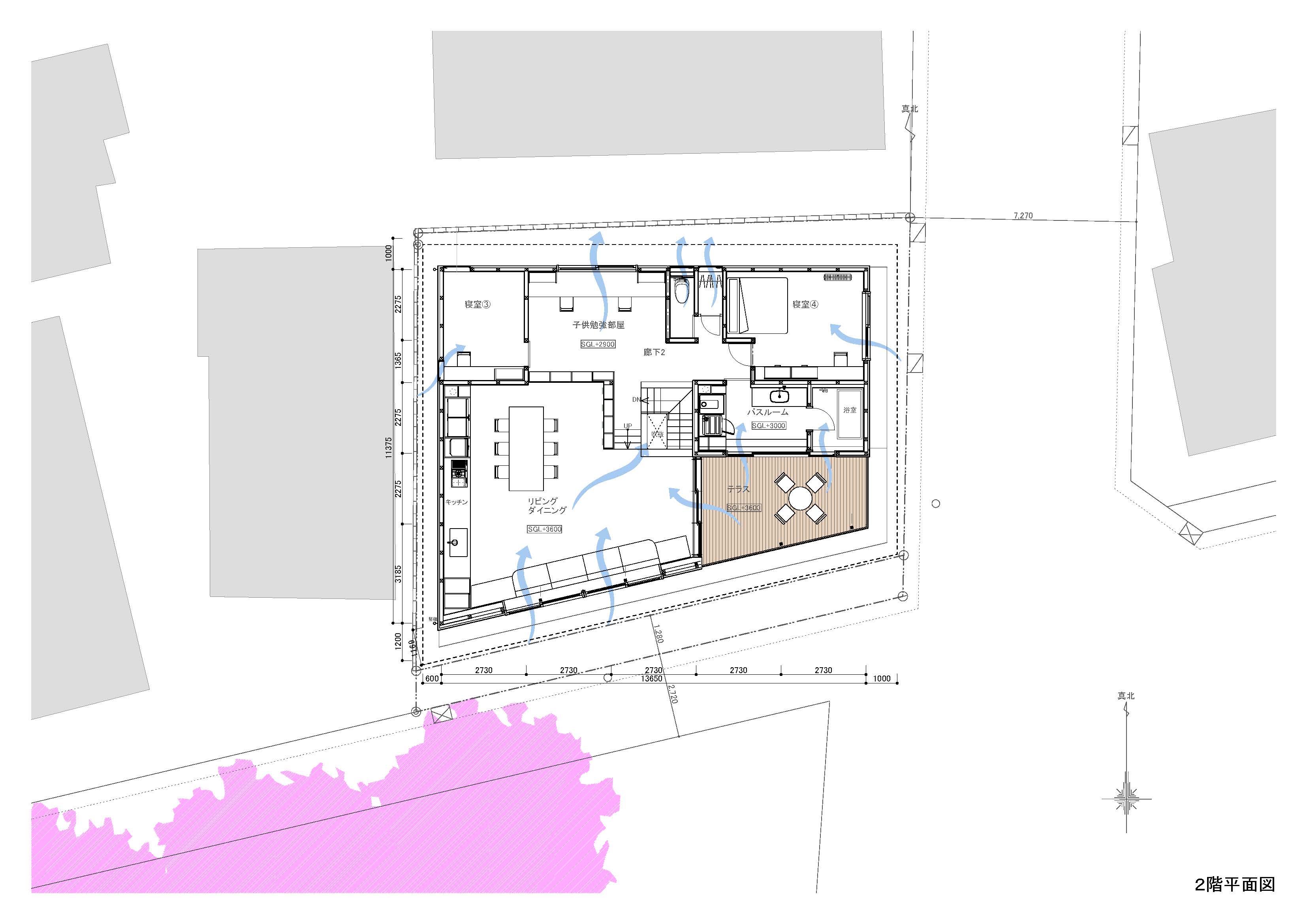
完整项目信息
项目名称:八雲的家
项目类型:建筑
项目地点:日本東京
建成状态:建成
设计时间:2022年3月—2023年3月
建设时间:2023年4月—2024年3月
用地面积:135平方米
建筑面积:265平方米
设计单位:小大建筑设计事务所 + 磯田和明
主创建筑师:小嶋伸也・小嶋綾香
设计团队完整名单:小嶋伸也・小嶋綾香・中村靖怡・板倉知也
施工:株式会社渡辺富工務店
结构:浜田英明建築構造设计
设备:Y.M.O. 合同会社
照明:株式会社大好照明
造园:石正園
窗帘:fabricscape
摄影师:堀越圭晋/ SS Tokyo
版权声明:本文由小大建筑设计事务所授权发布。欢迎转发,禁止以有方编辑版本转载。
投稿邮箱:media@archiposition.com
上一篇:木艺办公与融合展示:品初家居设计工作室 / 喜叻空间研究
下一篇:博风建筑+上海市政院新作:深圳光明环境园